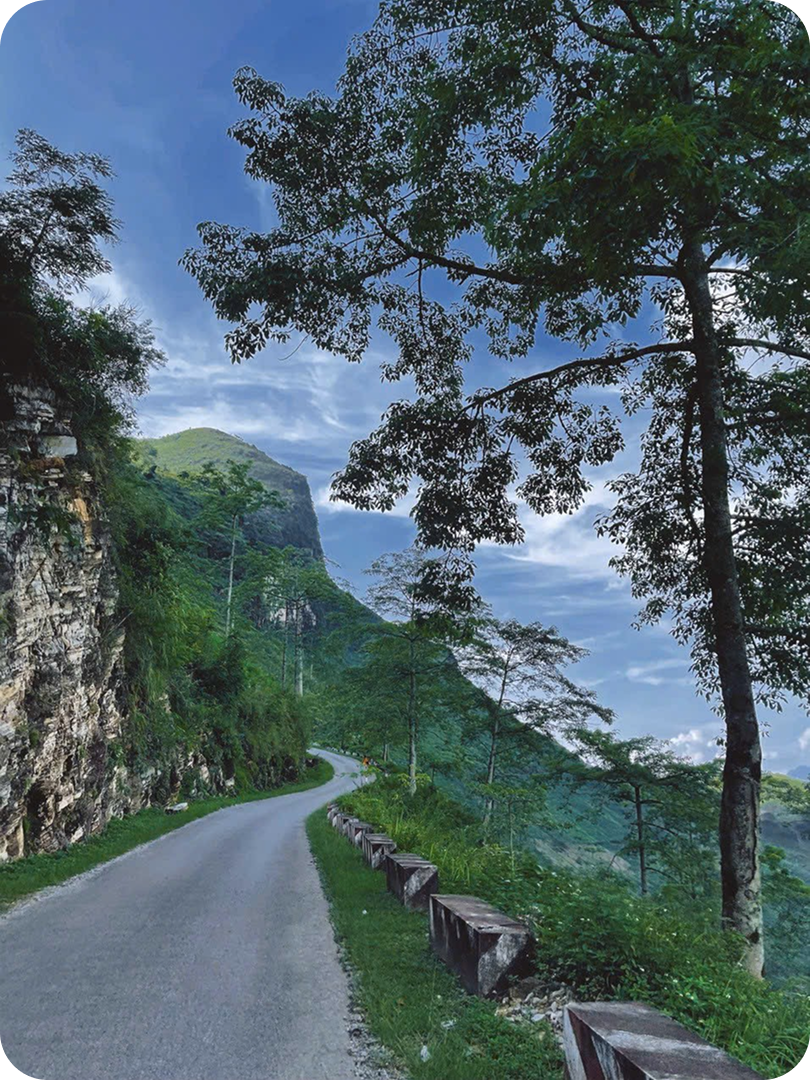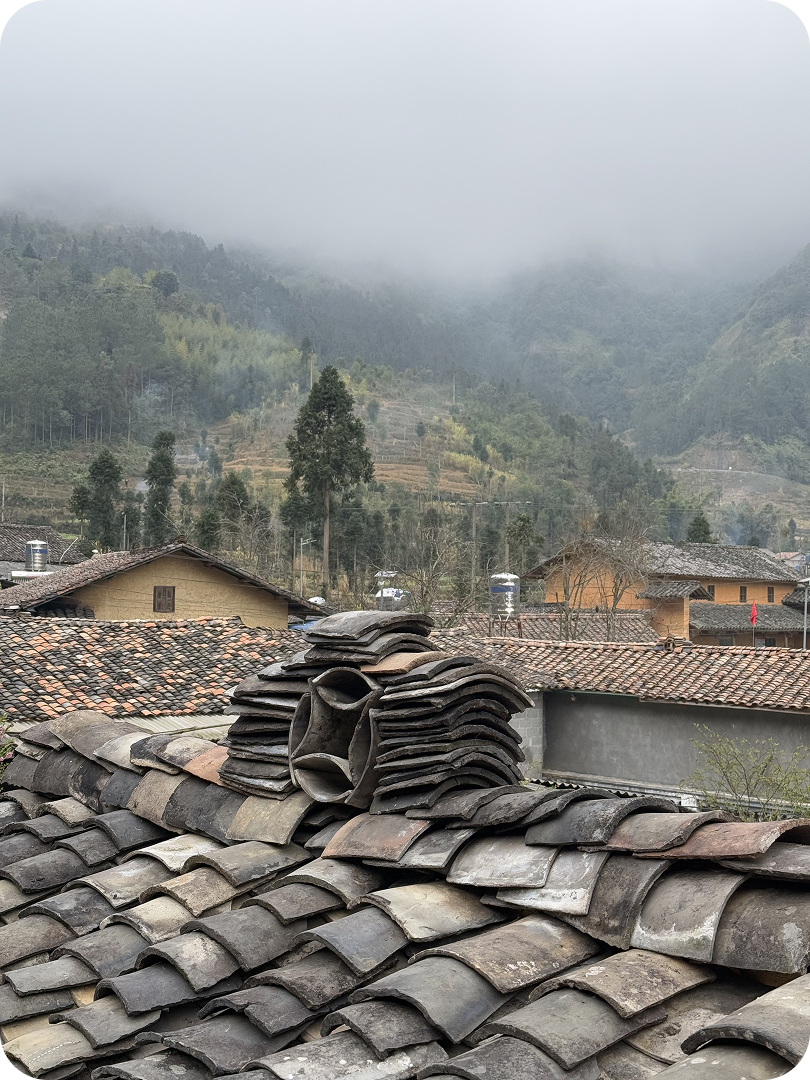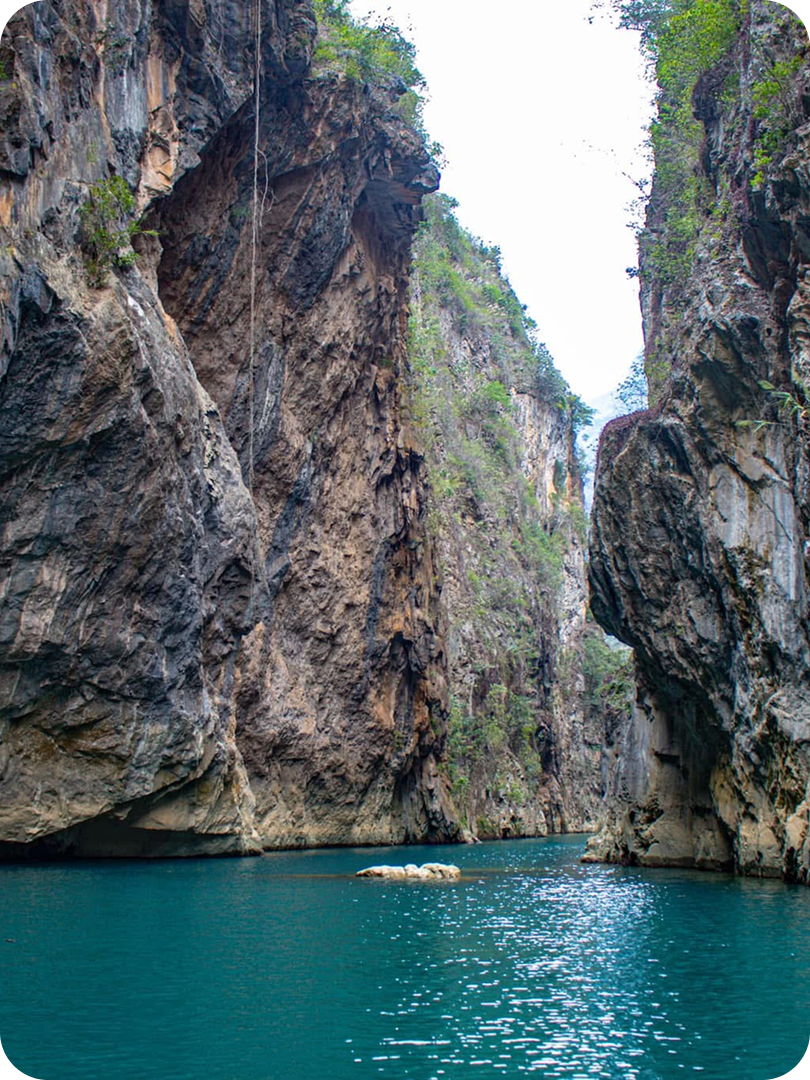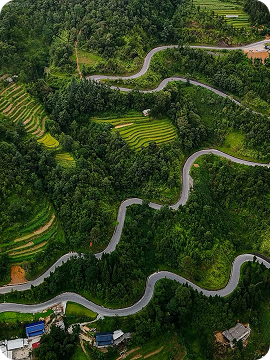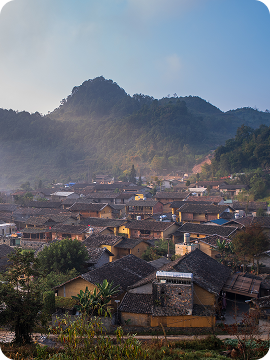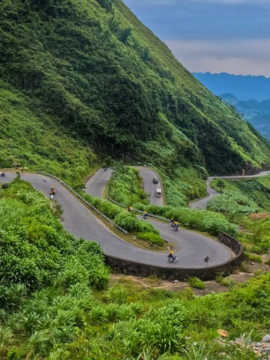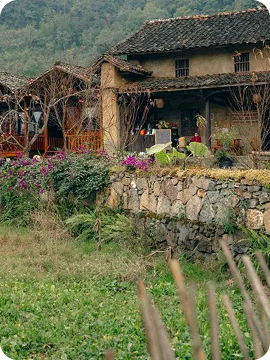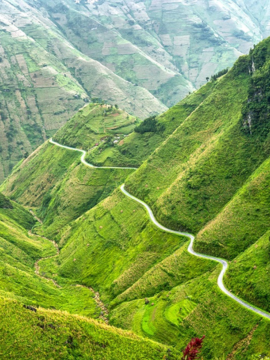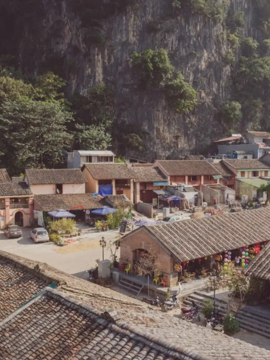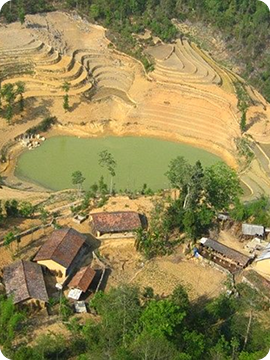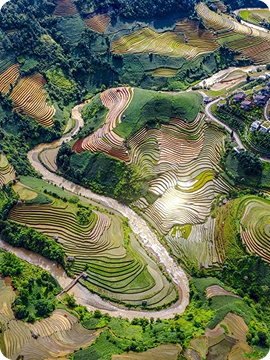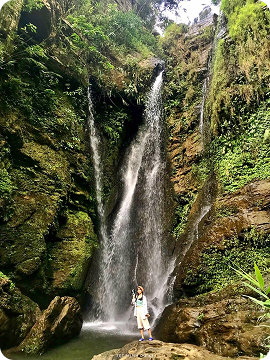 HA GIANG LOOP
HA GIANG LOOP
A life-changing adventure awaits with Phieu Travel
The Ha Giang Loop is a breathtaking journey through Vietnam’s northern highlands, offering travelers a unique blend of rugged landscapes, rich ethnic cultures, and authentic local experiences. This route showcases dramatic mountain passes, terraced fields, and vibrant villages, making it a must-visit for adventurous souls.
This article by Phieu Travel provides a detailed guide to help you explore the Ha Giang Loop with ease and insight.
1. What is the Ha Giang Loop?
The Ha Giang Loop is a stunning 350-kilometer (217-mile) motorbike route through Vietnam’s northernmost province. It is one of the most spectacular loop Vietnam routes, weaving through mountains and ethnic villages. Starting and ending in Ha Giang City, this 3 to 5-day journey crosses steep passes, deep valleys, and cliffside roads overlooking the emerald Nho Que River.
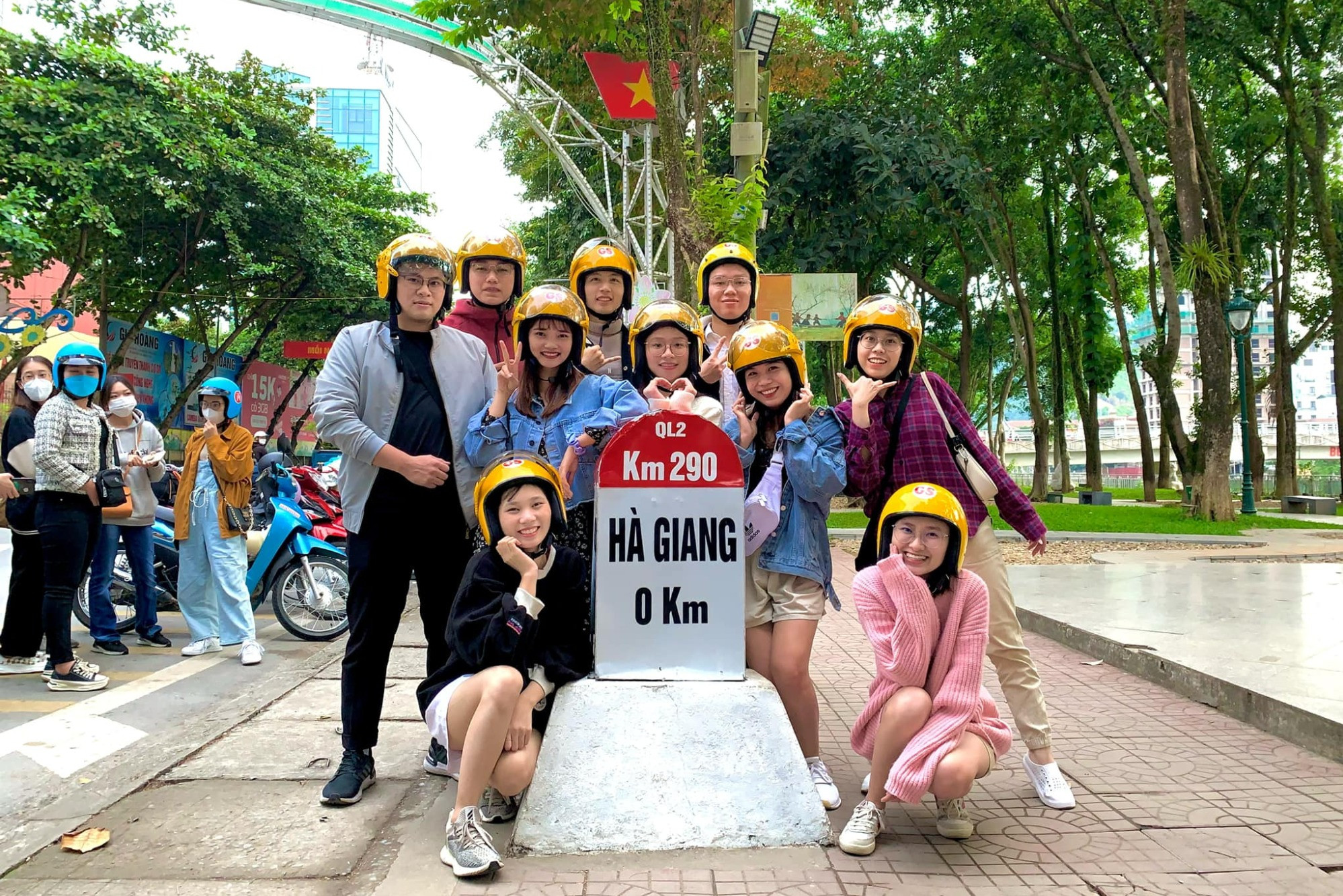
Beyond its dramatic landscapes, the Ha Giang Loop offers a vibrant cultural tapestry. The region is home to diverse ethnic communities, including the Hmong, Red Dao, Lo Lo, and Tay. Each group has its own traditions, housing styles, and daily rhythms. From the colorful clothing of the Lo Lo people to the stepped rice terraces maintained by the Tay, each village along the route reflects a different facet of local life.
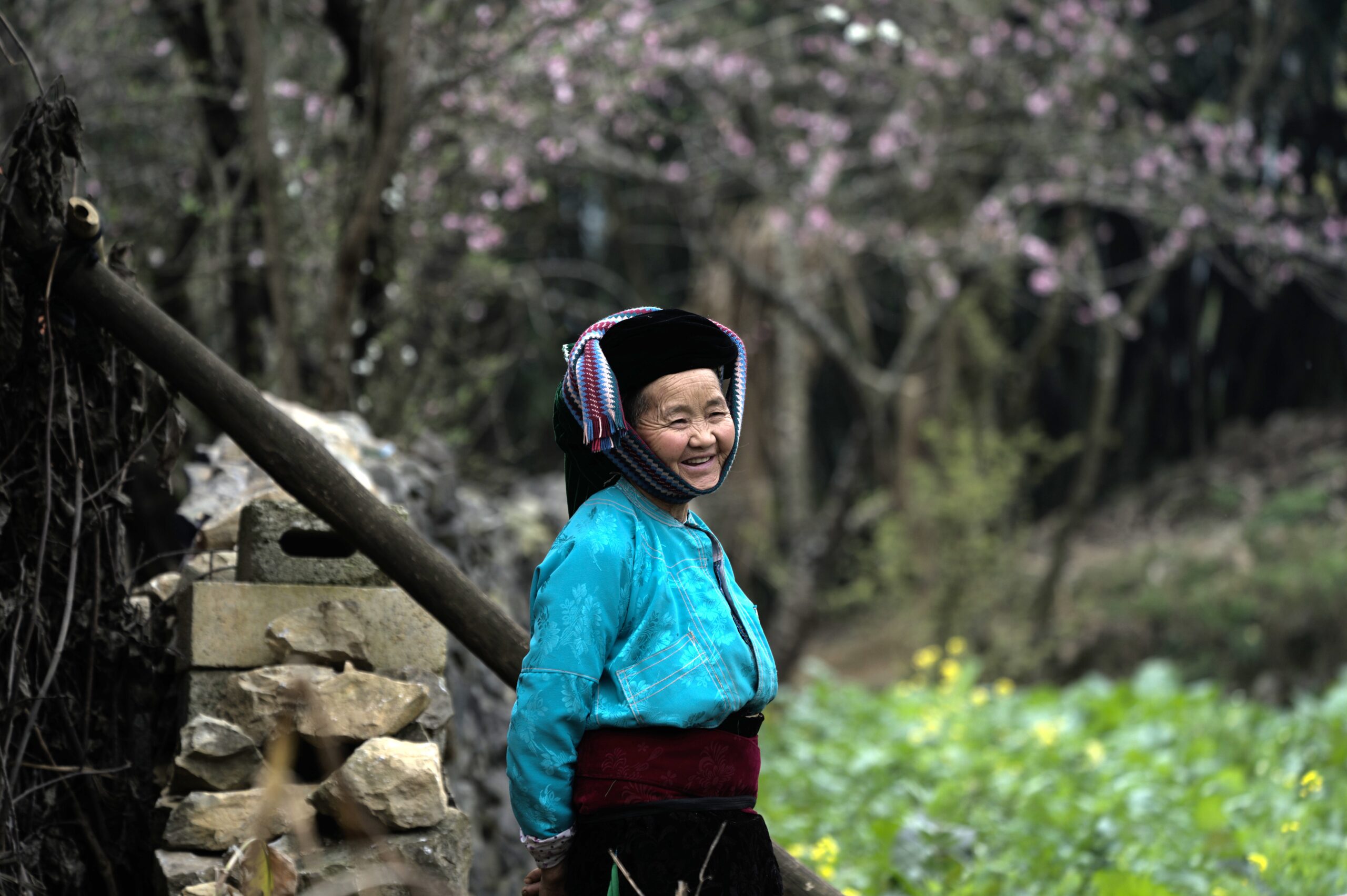
The Loop’s history is as remarkable as its scenery. Built between 1959 and 1965, the road was carved mostly by hand through rugged cliffs and valleys. Thousands of workers and volunteers from neighboring provinces took part in its construction, creating what locals proudly call the “Happiness Road.” This effort connected once-isolated mountain communities to the outside world.
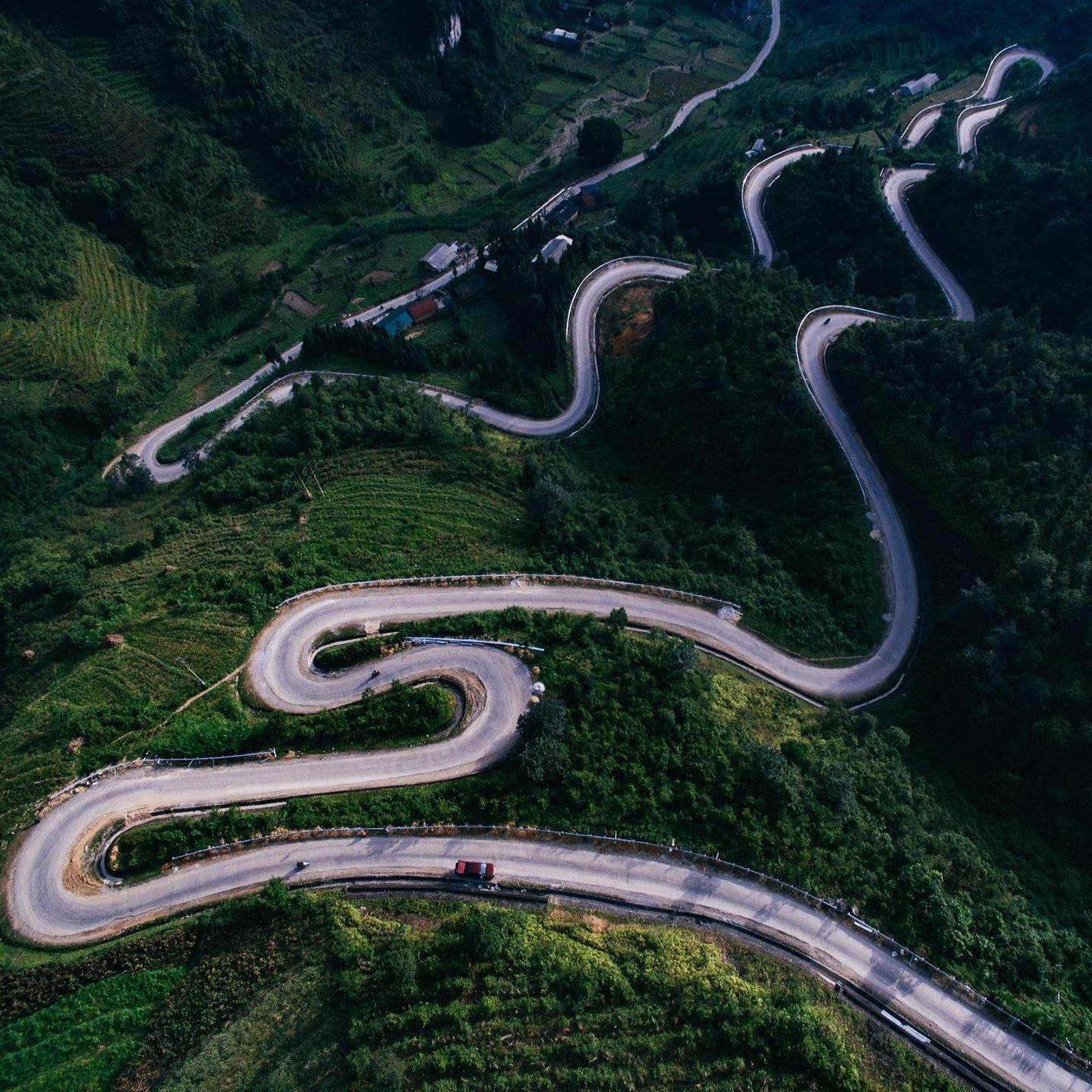
Today, the Ha Giang Loop is more than a motorbike adventure. It’s a journey through limestone peaks and terraced fields, and an opportunity to witness the living heritage of Vietnam’s northern highlands.
2. Top highlights along the Ha Giang Loop
Driving the Ha Giang Loop route, you’ll encounter a series of breathtaking landscapes and culturally rich destinations. From mountain passes and lush valleys to remote villages and historic landmarks, each stop along the way offers a new perspective on the beauty and diversity of northern Vietnam.
2.1 Quan Ba – Heaven’s Gate & Twin Mountains: Gateway to the Dong Van Karst Plateau with panoramic mountain views
Located about 43 kilometers north of Ha Giang City, Quan Ba is often seen as the first true milestone on the Ha Giang Loop. This district marks the gateway to the Dong Van Karst Plateau Geopark, where landscapes shift from gentle foothills to dramatic limestone peaks and mist-filled valleys. The journey along Happiness Road (Highway 4C) begins to reveal the rugged beauty that defines the region.
One of Quan Ba’s most iconic stops is Heaven’s Gate, perched at over 1,500 meters above sea level. From this height, travelers enjoy sweeping panoramic views of terraced fields, sharp limestone ridges, and valleys stretching endlessly toward the horizon. On misty mornings, the entire landscape takes on a dreamlike, almost surreal quality, making it a favorite stop for photography lovers.
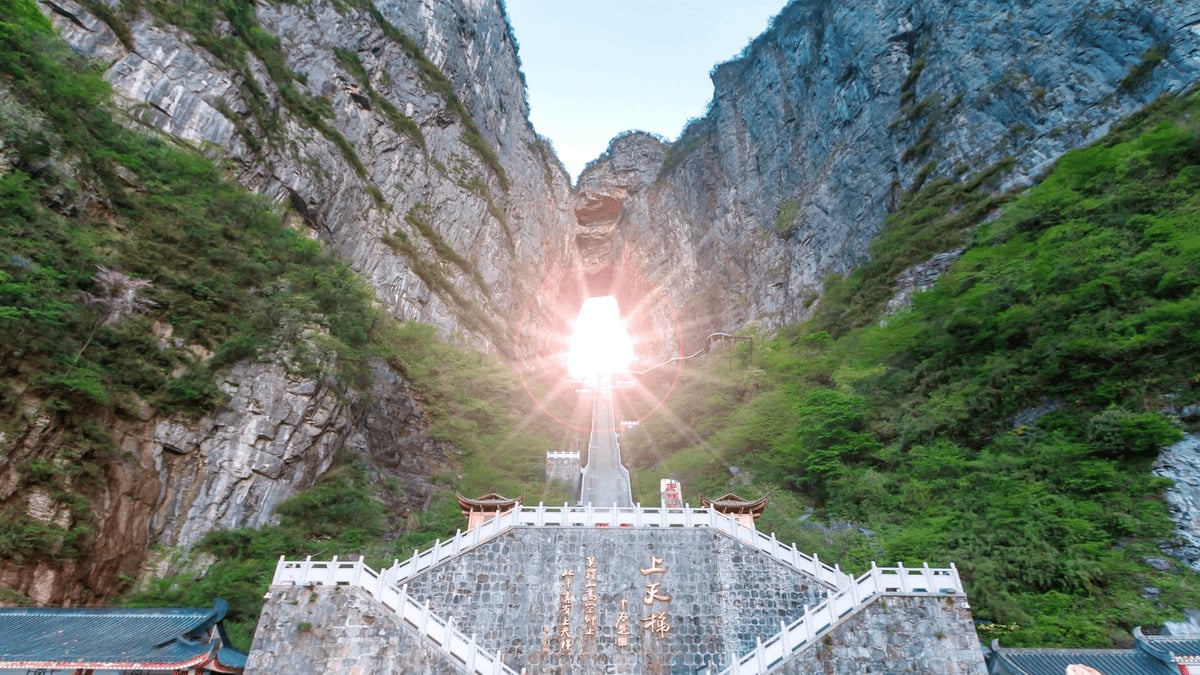
Just below the pass, the Quan Ba Twin Mountains rise prominently from the valley floor. Known locally as the “Fairy Bosom,” these two rounded hills are tied to a Hmong legend about a mountain fairy who left her bosom behind to nurture her child. Whether blanketed in the vibrant greens of summer or the golden tones of harvest, this natural formation remains one of the most photographed sights in Ha Giang.
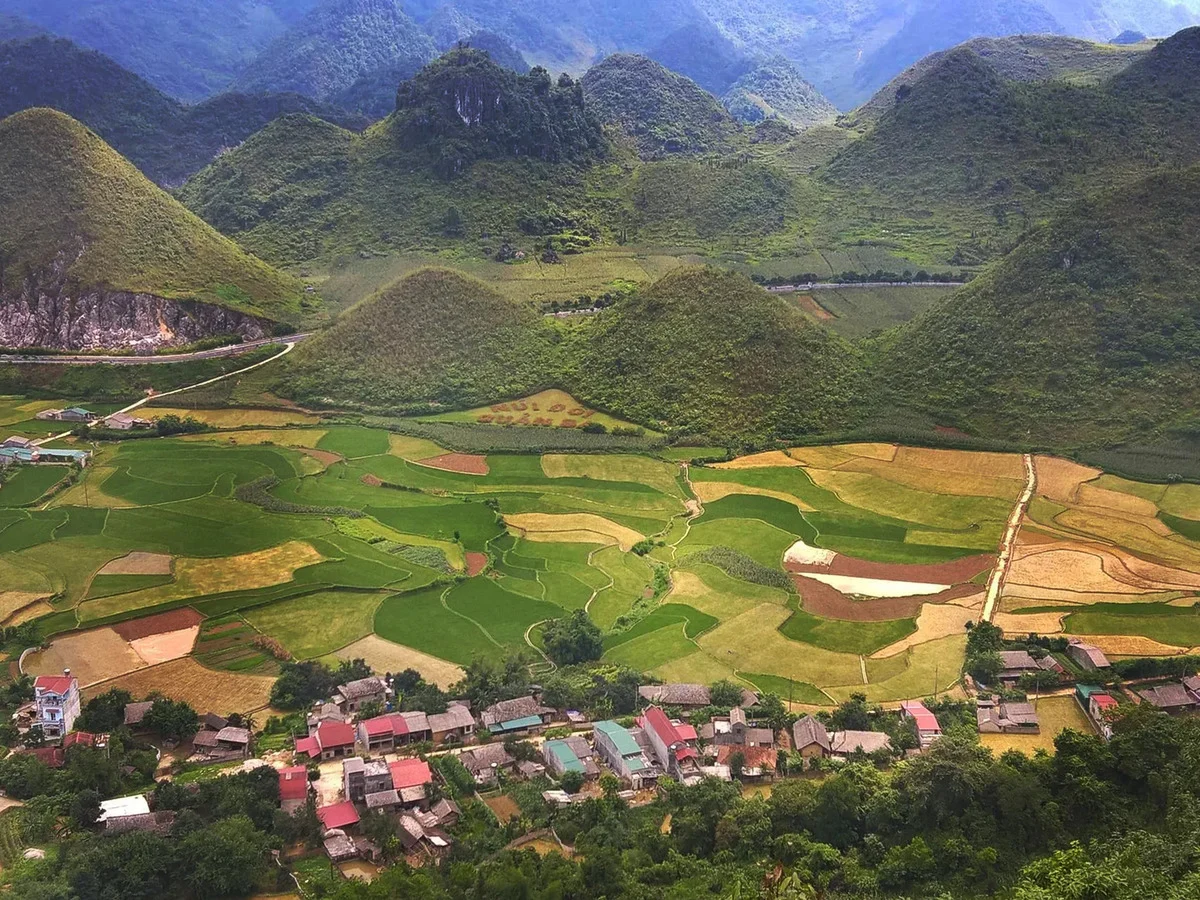
Each season adds a different charm to Quan Ba. Spring brings blooming flowers and newly planted rice terraces. Late summer and early autumn cover the fields in golden hues, while October ushers in the soft pink and purple of buckwheat flowers, giving the landscape a gentle, poetic touch.
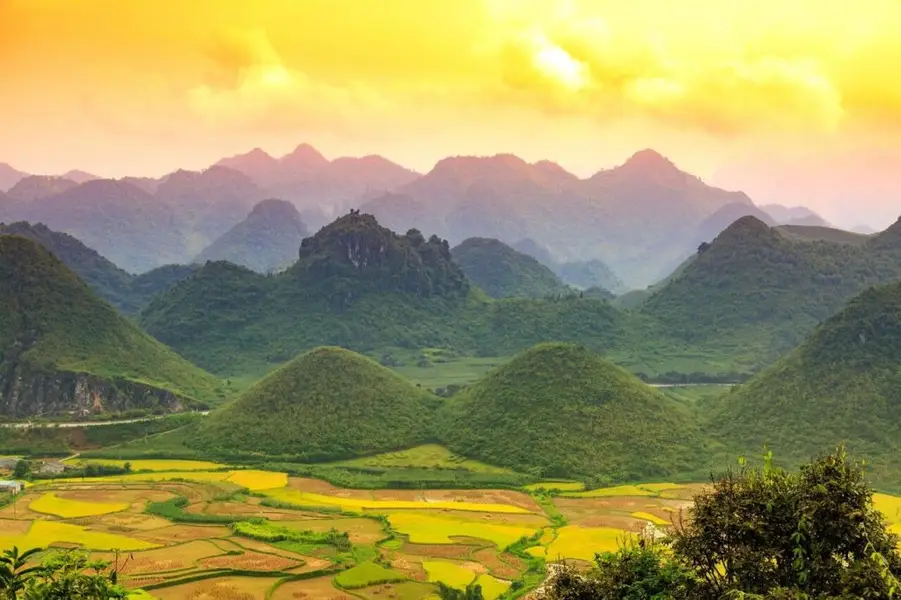
2.2 Yen Minh: Pine forests, terraced fields, and fresh highland air
Leaving Quan Ba behind, the Ha Giang Loop continues toward Yen Minh District, about 41 kilometers further along Happiness Road (Highway 4C). Known for its calm, open landscapes, Yen Minh offers a softer contrast to the rugged cliffs of earlier sections.
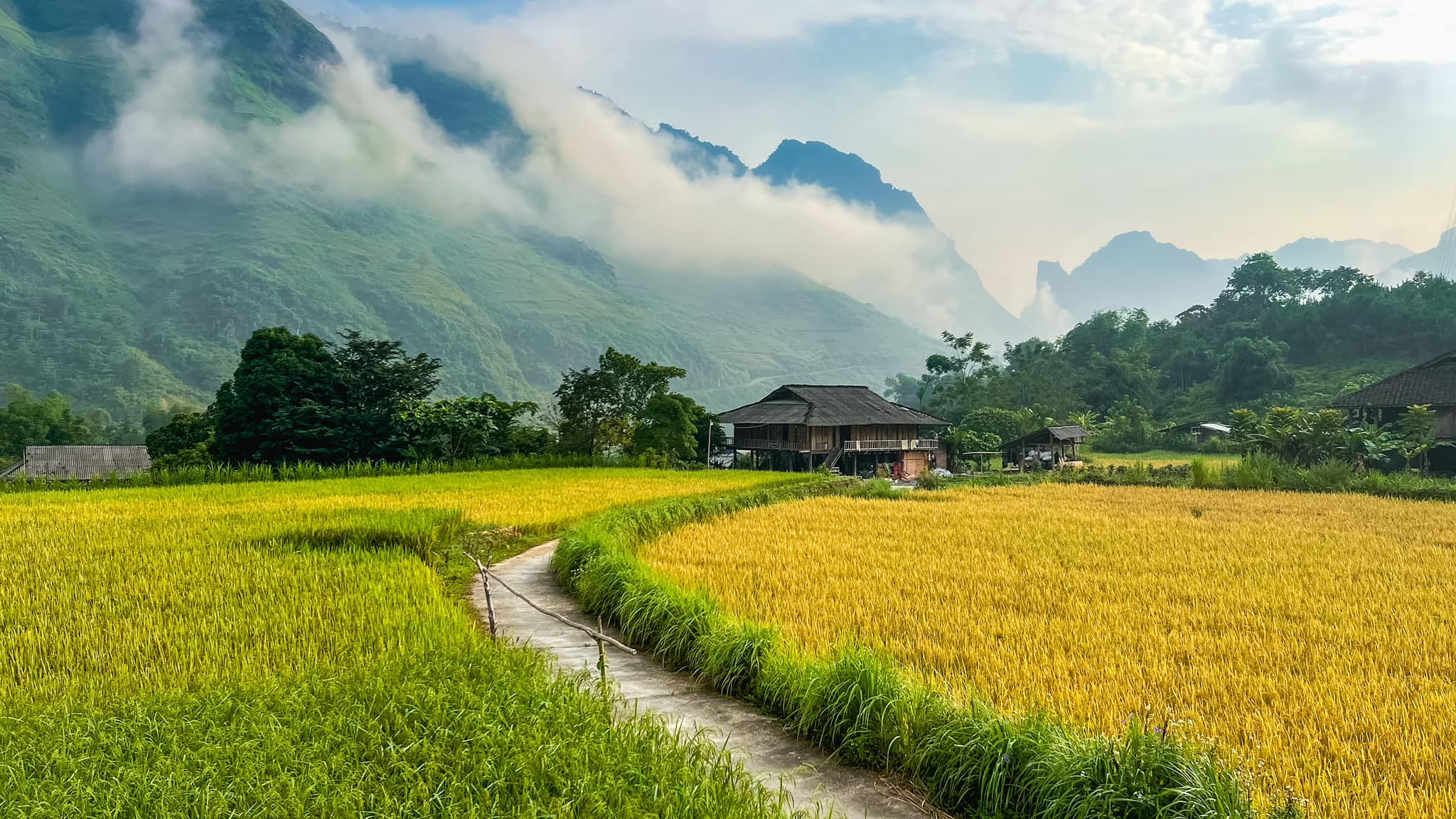
The most iconic destination here is the Yen Minh Pine Forest. Spanning nearly 100 hectares from Na Khe Village to Yen Minh Town, this stretch of slender pines creates one of the most beautiful forested scenes in northern Vietnam. The air carries a distinct alpine freshness, especially in early mornings when mist lingers along the hillsides.
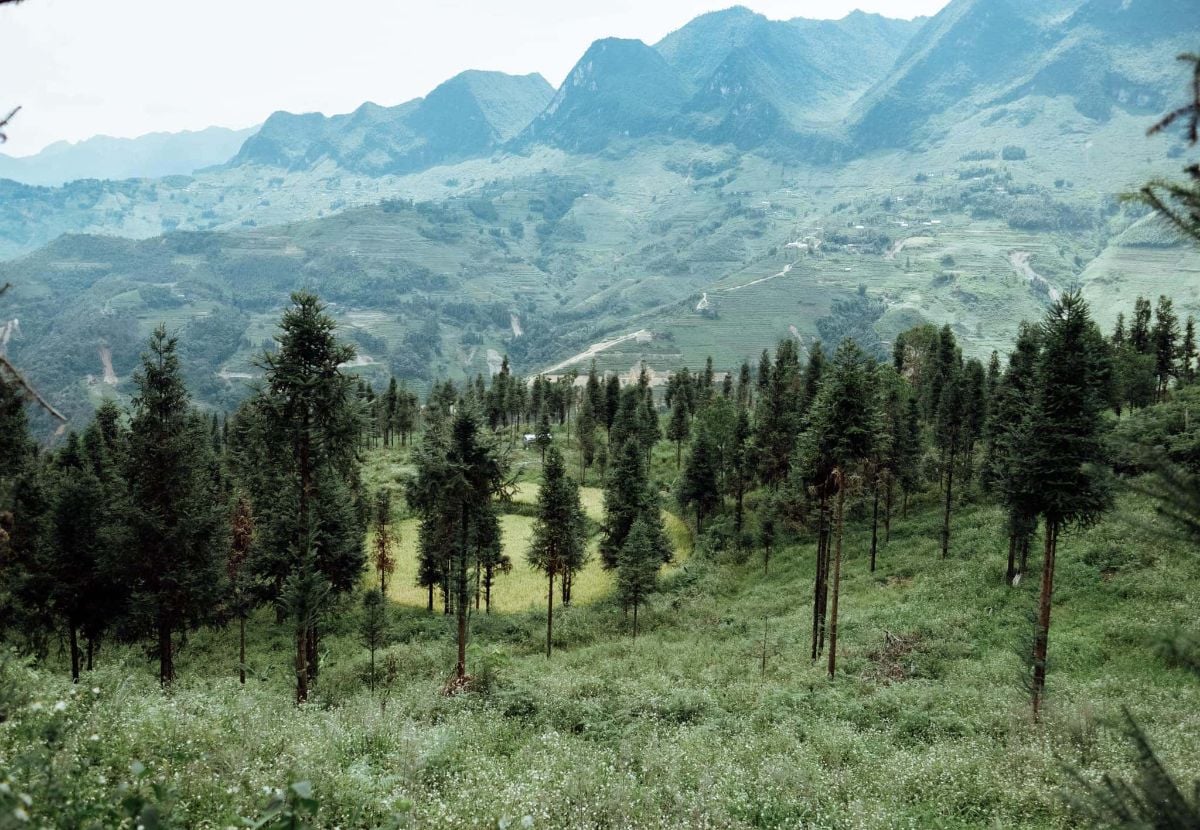
Beyond the pine forest, Yen Minh’s terraced fields unfold across valleys and hillsides. Each season paints a new layer of color: young green shoots in spring and early summer, then a golden glow by late September when harvest begins. These rice terraces, shaped by generations of ethnic Hmong and Dao farmers, offer stunning, photogenic views along the route.
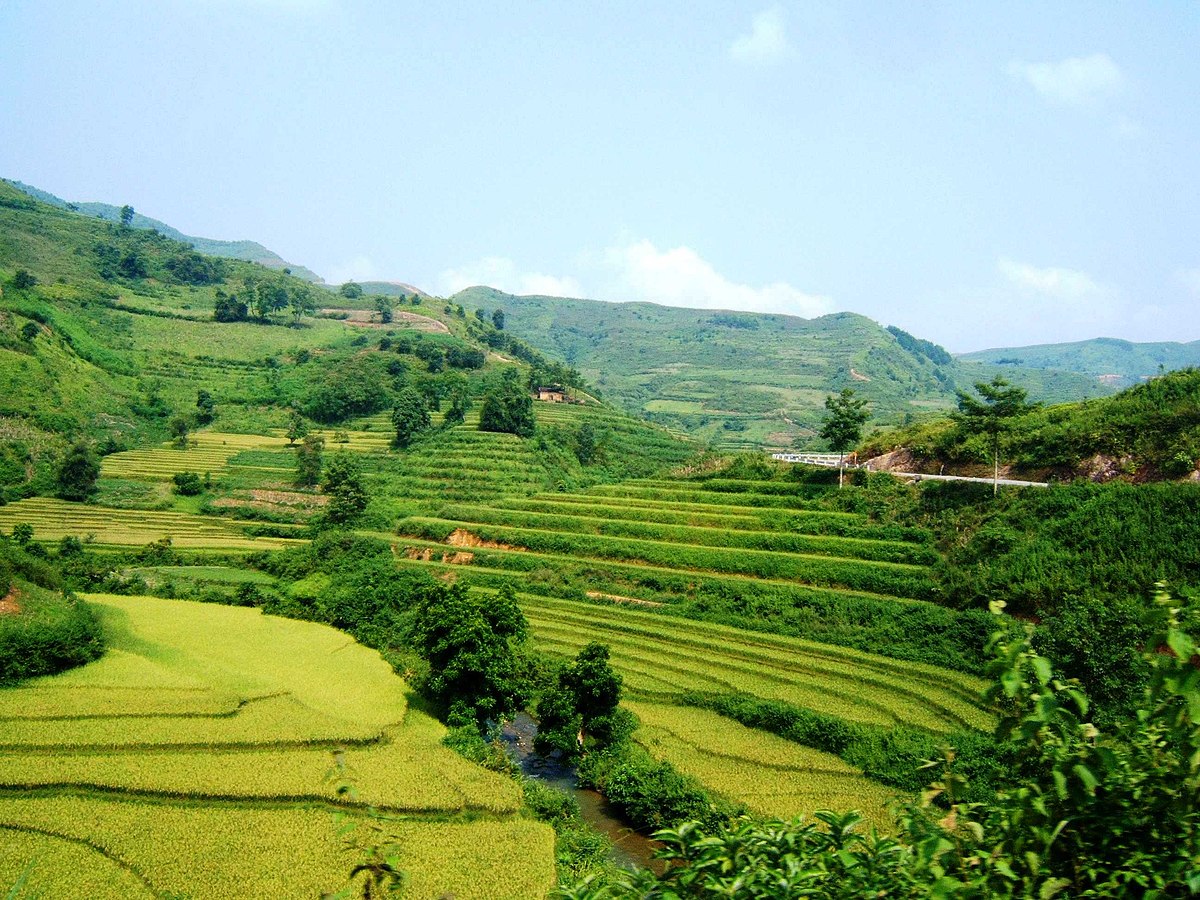
For travelers craving more than a passing glance, Yen Minh invites you to slow down. Spend time trekking through the pine woods, breathe in the crisp highland air, or explore small ethnic villages scattered across the hills. Here, traditional wooden houses nestle between fields and forests, offering glimpses of daily life in Vietnam’s remote uplands.

2.3 Dong Van: Cultural and historical center with ancient town, local markets, and the Hmong King’s Palace
Perched between 1,000 and 1,600 meters on the Dong Van Karst Plateau, Dong Van sits quietly amid limestone peaks and cool mountain air. Mornings here often start with a thin mist covering the rooftops, giving the town a soft, muted beauty. As part of a UNESCO Global Geopark, Dong Van is not a place of grand size but of layered history. Each turn along its streets reveals traces of both nature and long-settled communities.
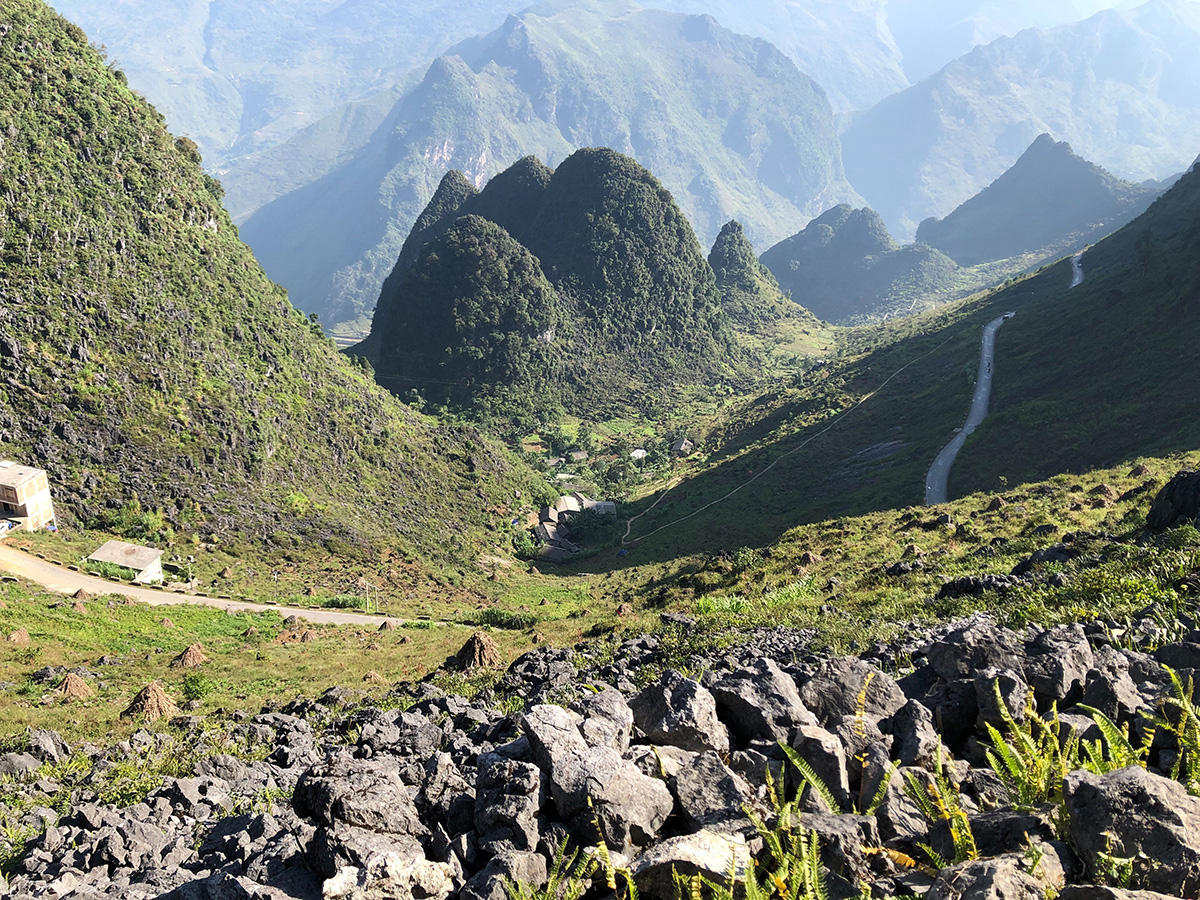
In the center of town, Dong Van Ancient Town preserves traces of the early 20th century. Stone-built houses with yin-yang tiled roofs line narrow alleys, their wooden balconies looking down on cobbled lanes. The architecture reflects the hands and styles of Tay, Hmong, Hoa, Nung, and Dao families who have lived here for generations. Despite changes over time, the streets still carry the slow rhythm of highland living.
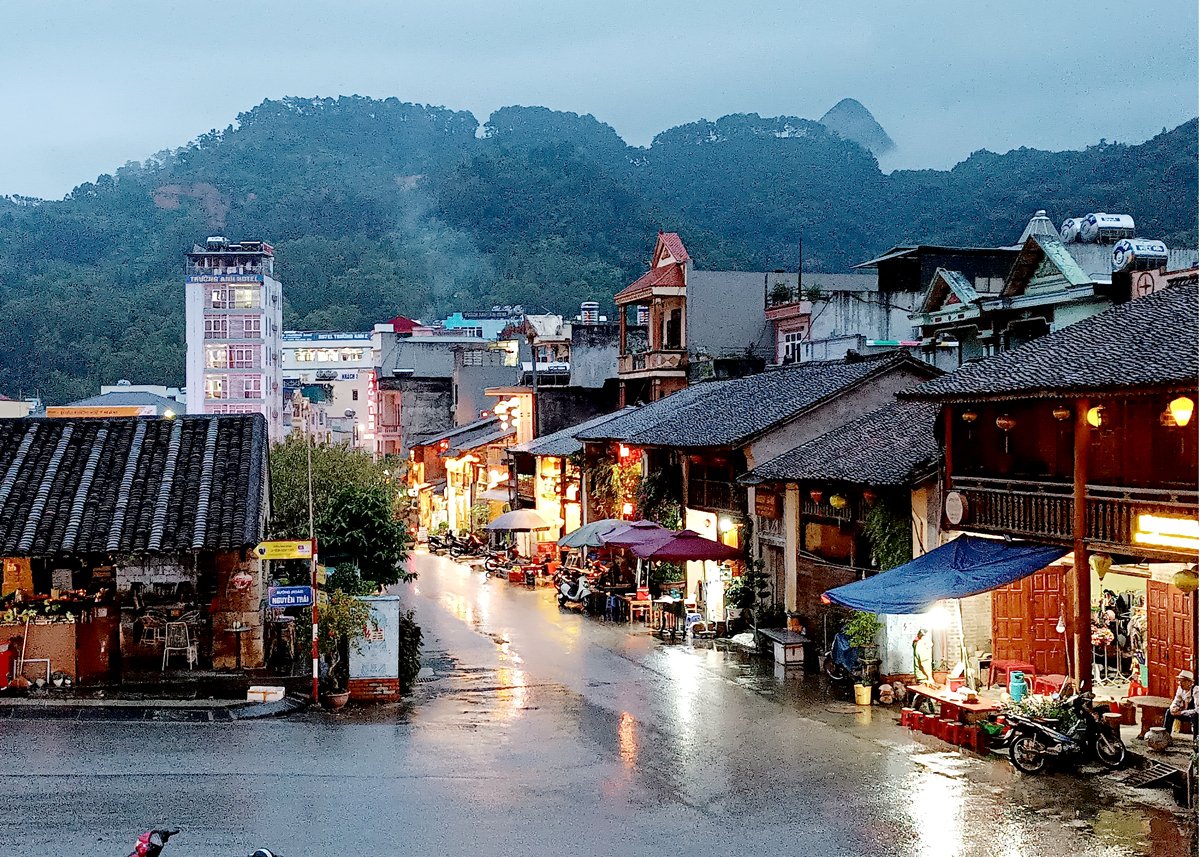
Sundays bring a different atmosphere as Dong Van Market fills with color and voices. Ethnic villagers from nearby communes gather with woven baskets, selling everything from fresh vegetables to handmade cloth. Cooking fires burn along the market edge, giving off the scent of grilled meats and sticky rice cakes. For visitors, this is one of the few places to observe real trade and social life unfolding naturally in the highlands.
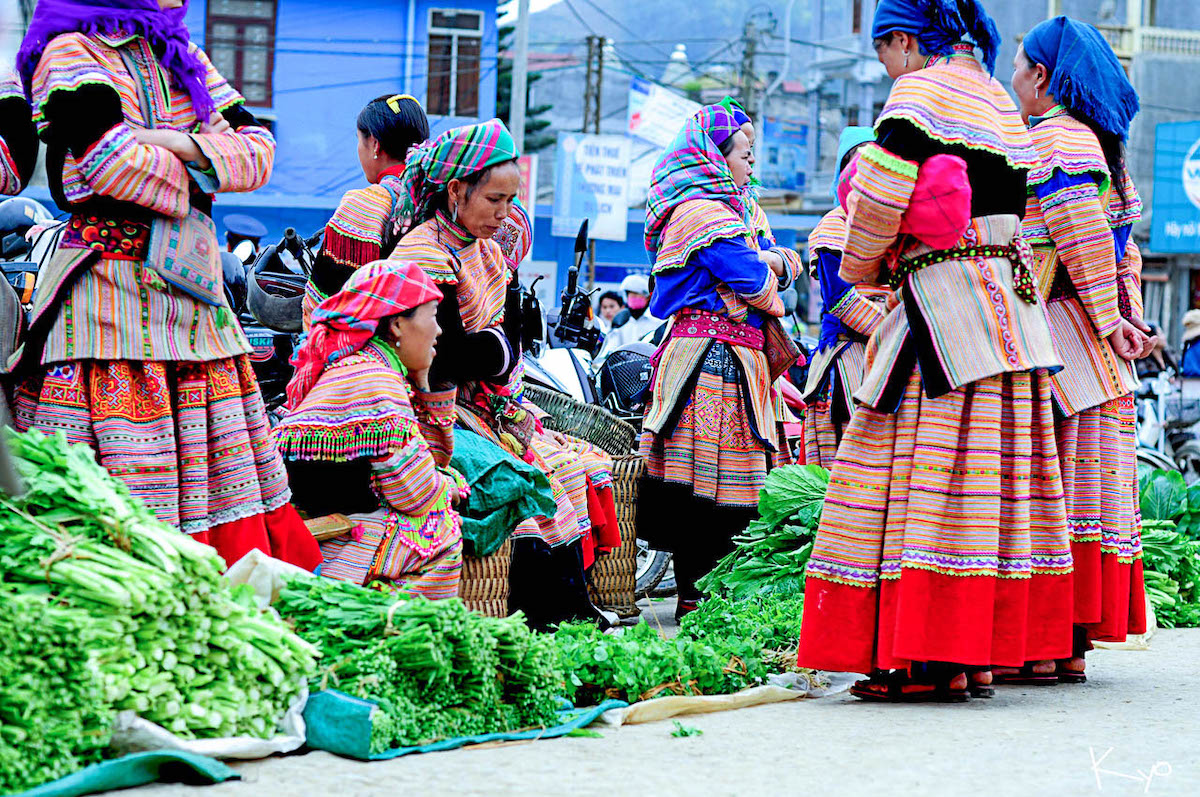
About 14 kilometers from Dong Van, the Hmong King’s Palace in Sa Phin Commune stands behind stone walls shaded by old trees. Built by Vuong Chinh Duc in the early 20th century, the residence blends French layout with Hmong details. Thick wooden pillars, poppy bud carvings, and fortress-like design reflect both wealth and the family’s historical role in Ha Giang.
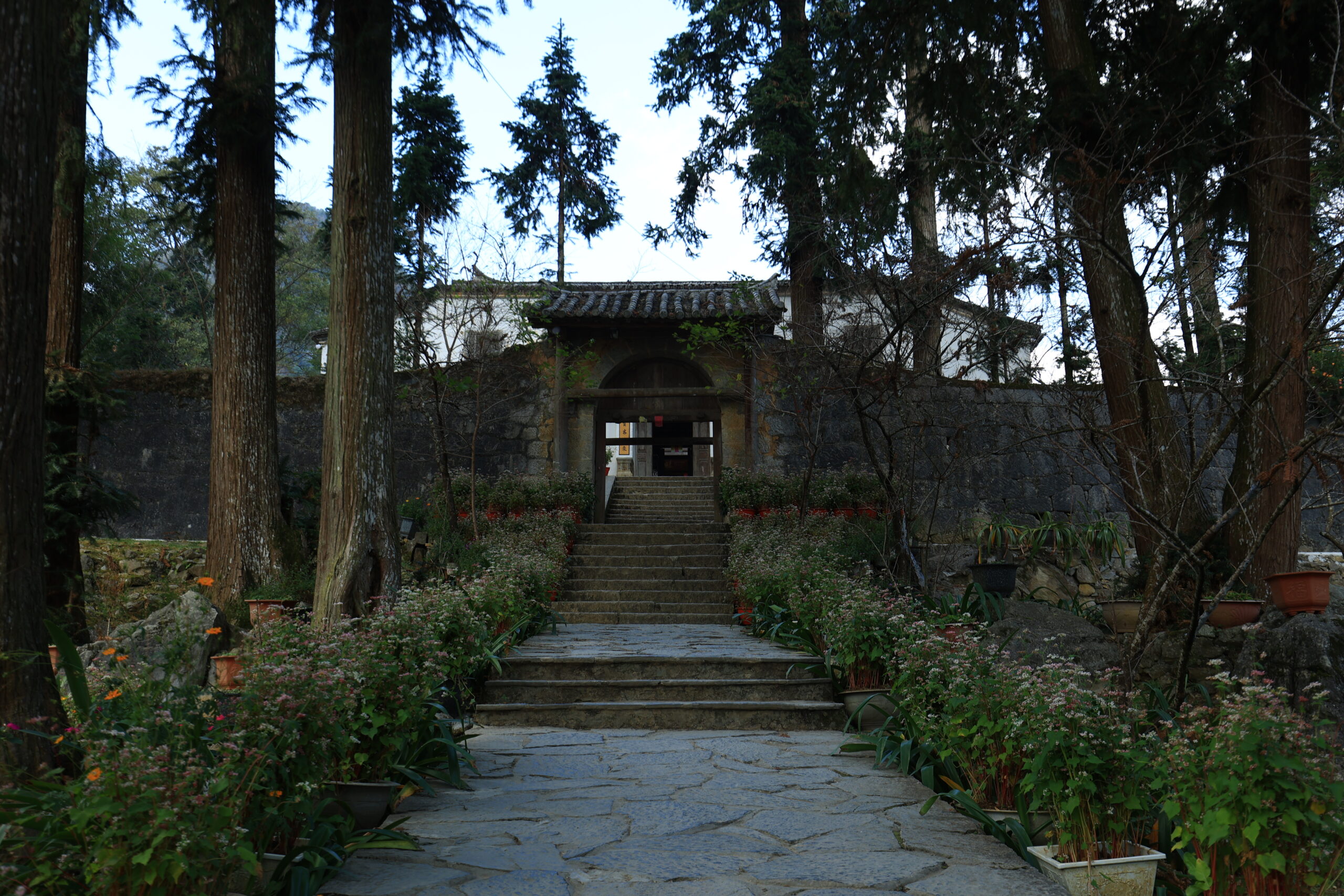
2.4 Lung Cu: Northernmost point of Vietnam and the iconic Lung Cu Flag Tower
Lung Cu lies over 1,400 meters above sea level, close to the Chinese border, marking Vietnam’s northernmost point. The landscape here opens to limestone peaks, terraced fields, and valleys often covered in morning mist. Among the highlights of Lung Cu is Rong Mountain, a high ridge overlooking the surrounding countryside. This is where visitors will find the iconic Lung Cu Flag Tower, a powerful symbol of national pride.
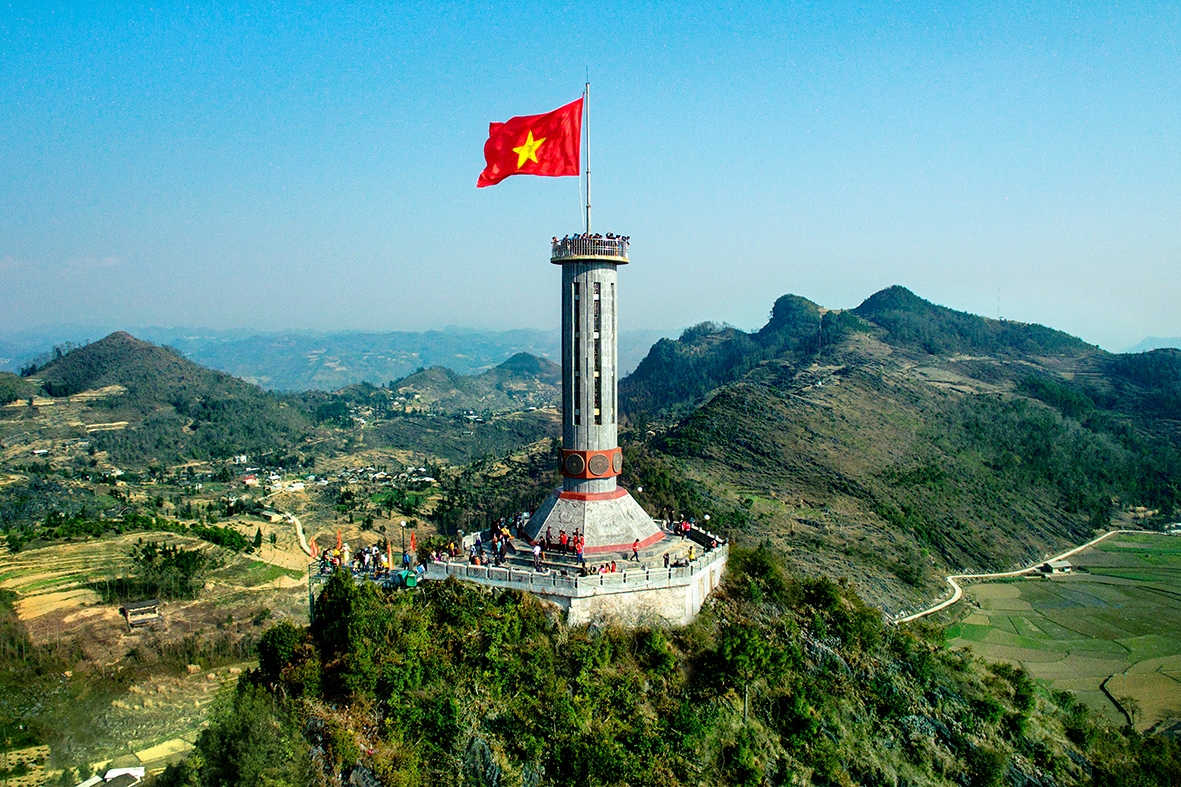
The tower reaches 33 meters, with an octagonal base and a 9×6 meter red flag symbolizing Vietnam’s 54 ethnic groups. Visitors climb 839 stone steps, or 283 from the upper parking area, to reach the summit. From here, the view spans across Ha Giang’s valleys and, on clear days, into parts of southern China. The climb is steady but rewards every effort with sweeping highland vistas.
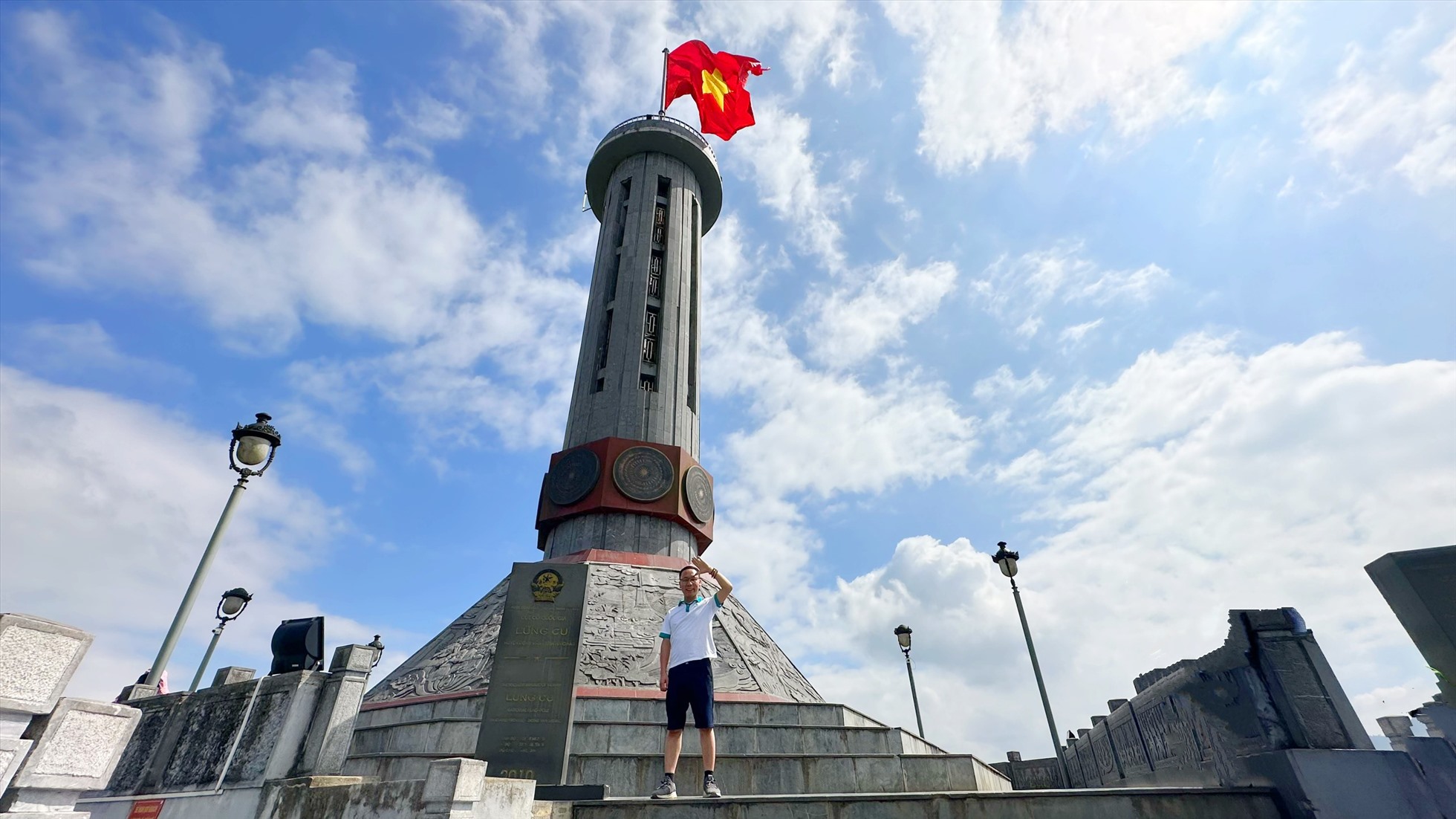
The history of the Lung Cu Flag Tower dates back to the 11th century, when General Ly Thuong Kiet first raised a flag here. The structure was later rebuilt during the French colonial period and again in 2010. Surrounding the tower are symbolic features like Dong Son drum motifs and eight engraved green stones, each reflecting important milestones in Vietnam’s cultural history.
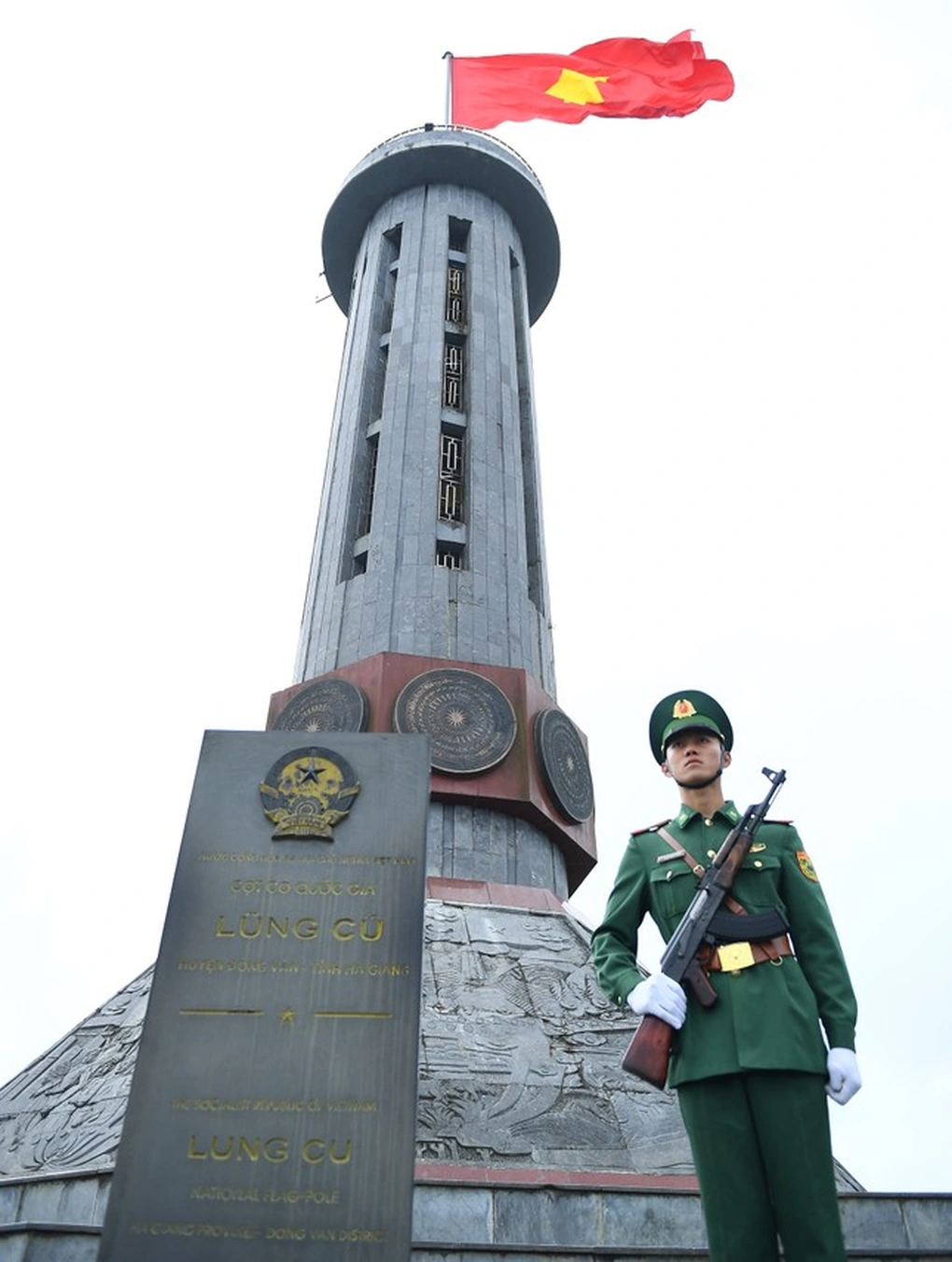
Beyond the flag tower, Lung Cu’s villages like Lo Lo Chai and Seo Lung reflect the area’s cultural depth. The Hmong and Lo Lo communities still practice terrace farming, hand-weaving, and seasonal rituals tied to the land. Rammed earth houses with stone fences sit quietly against the slopes, offering travelers a glimpse of life shaped by both tradition and terrain.
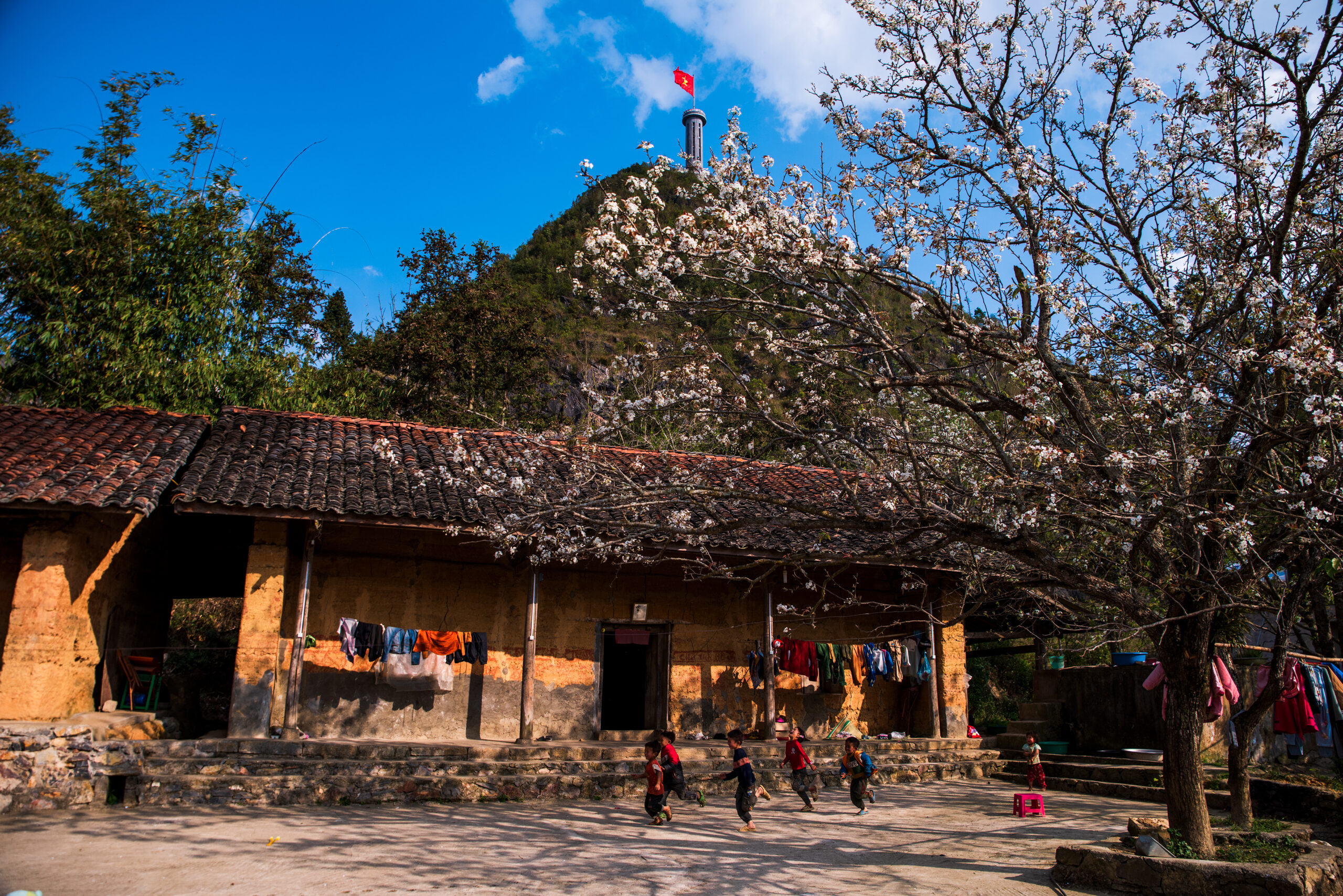
2.5 Ma Pi Leng – Nho Que River: Vietnam’s most dangerous pass with stunning views of the emerald-green Nho Que River
Ma Pi Leng Pass stretches around 20 kilometers between Dong Van and Meo Vac, reaching an altitude of 1,500 meters. Built in the 1960s by ethnic minority workers, this section of National Road 4C – known as the Happiness Road – is infamous for its steep cliffs, sharp hairpin bends, and narrow lanes hugging the mountainside. It remains one of Vietnam’s most challenging yet breathtaking routes.
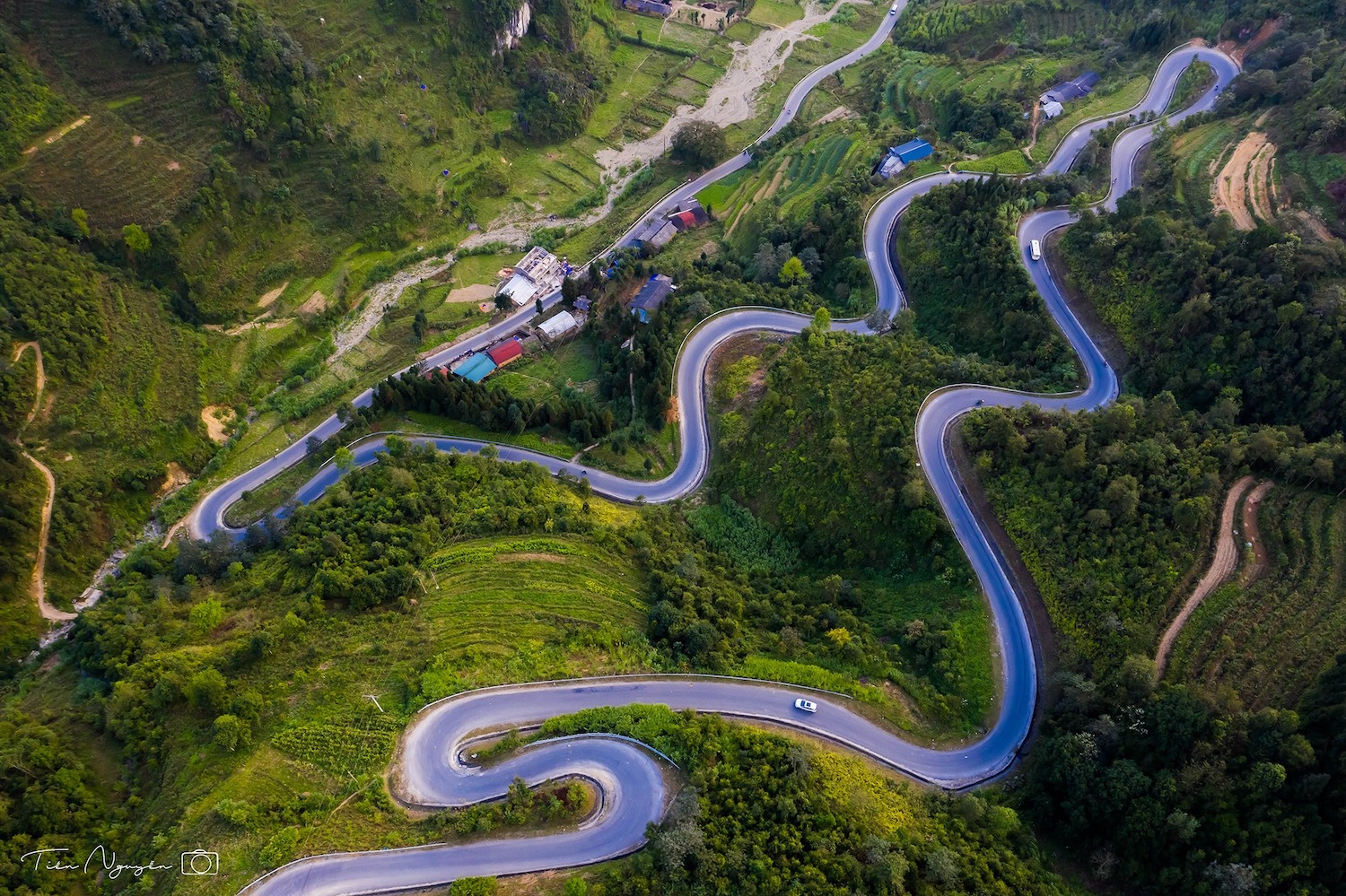
The pass offers uninterrupted views of limestone peaks and deep valleys. Below, the Nho Que River cuts through Tu San Gorge, with emerald-green water winding between sheer rock walls. On clear days, the scenery stretches endlessly, with layers of mountain ridges fading into soft blue horizons. For many travelers, this is the most photogenic section of the entire Ha Giang Loop.
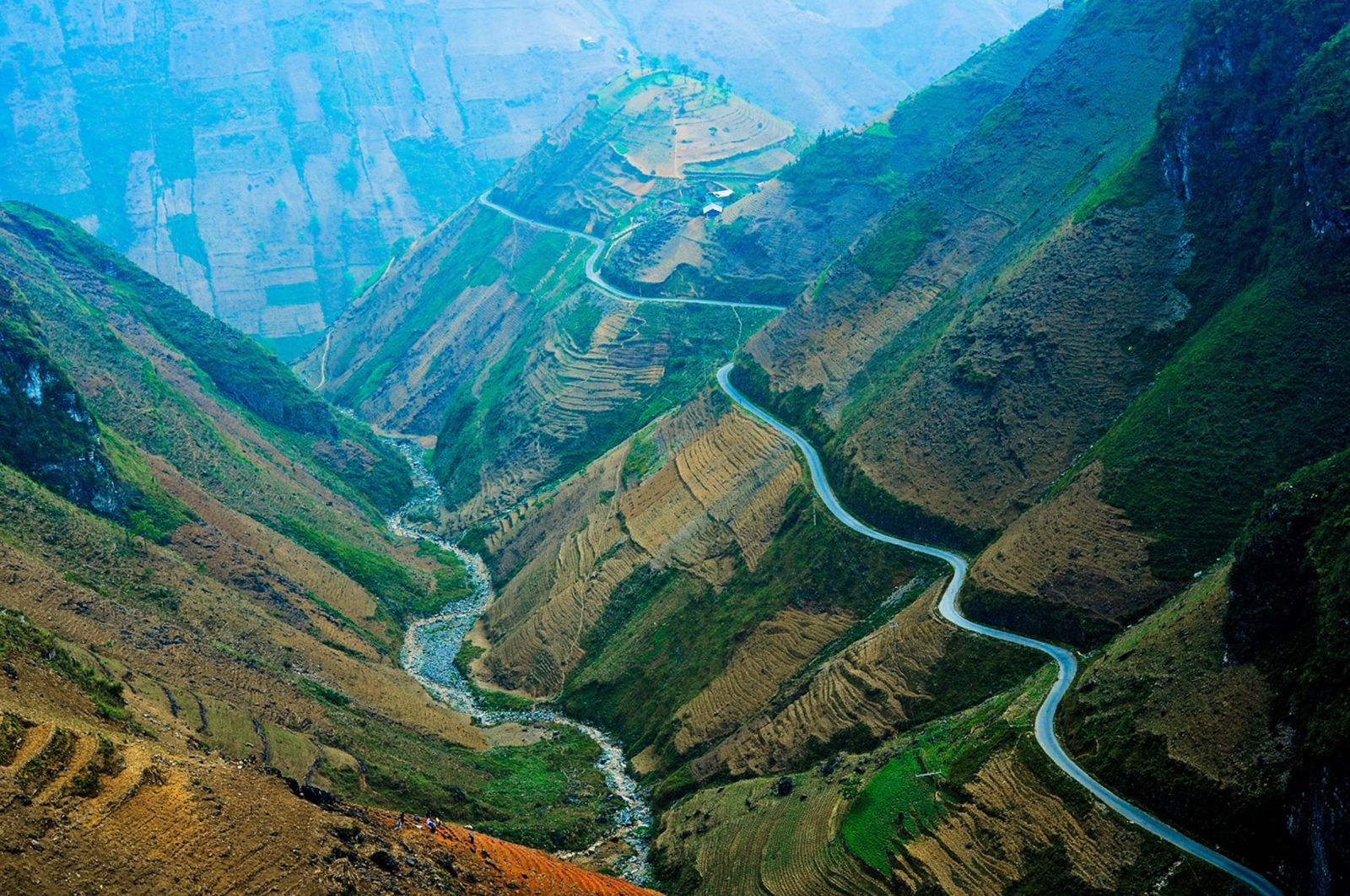
Along the route, several safe viewpoints invite visitors to pause for photos. The Ma Pi Leng Skywalk, starting near the Happiness Road Museum, offers a concrete path hugging the cliff edge. Though narrow, the Skywalk has been widened in recent years, making it accessible for both walkers and experienced motorcyclists. The feeling of standing at the edge, with clouds rolling below, leaves a lasting impression.
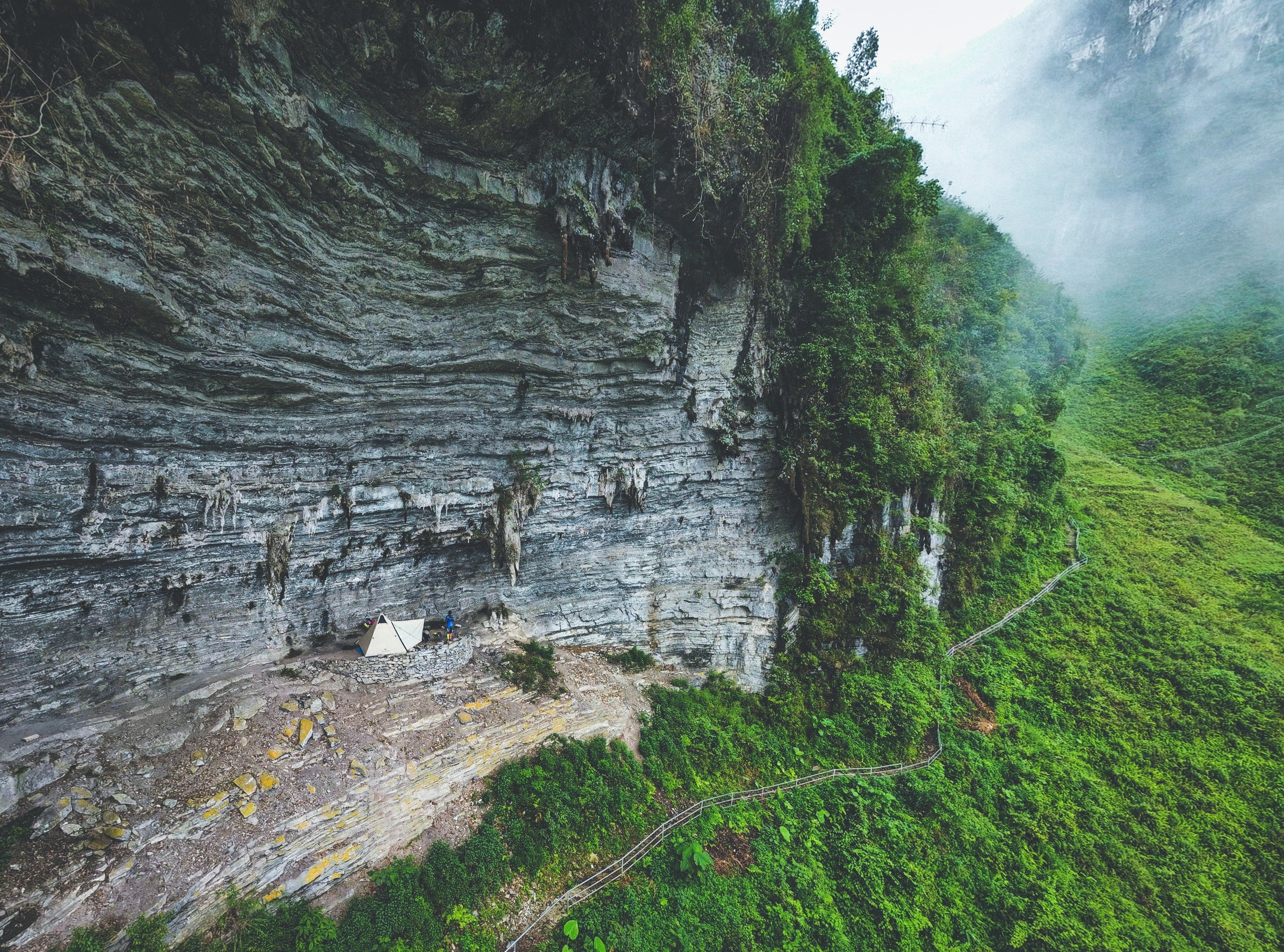
For a different perspective, visitors can explore the Nho Que River below. From boat docks in Ta Lang village or Xin Cai commune, short boat trips take travelers deep into Tu San Gorge. Floating between vertical cliffs, with green water beneath and towering rock walls above, offers a quiet, close-up view of this dramatic landscape.
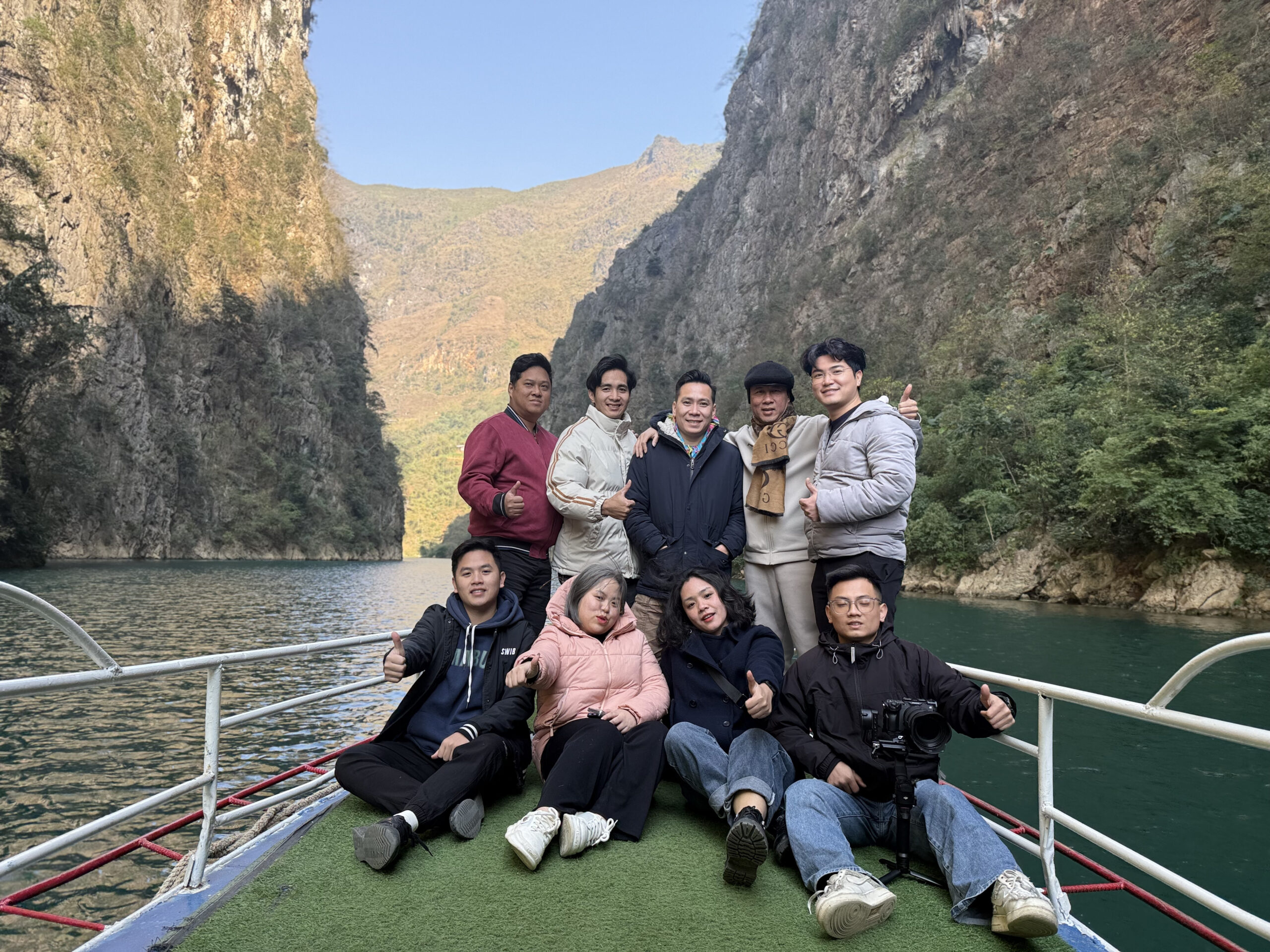
The best time to experience Ma Pi Leng is from October to February when skies stay clear and rainfall is minimal. Morning air can be cold, especially at higher elevations, so warm layers are recommended for both comfort and safety while traveling the pass.
2.6 Meo Vac & Du Gia: Ethnic villages, waterfalls, terraced rice fields, and authentic homestay experiences
Meo Vac lies deep within limestone valleys, framed by terraced rice fields and steep cliffs. The landscape shifts with the seasons, from green rice shoots to golden harvest fields. Every Sunday, Meo Vac Market becomes a gathering spot where villagers trade produce, livestock and crafts. The air carries the scent of grilled meats and sticky rice. Stalls open early with baskets of vegetables, herbs and tools from nearby hills.
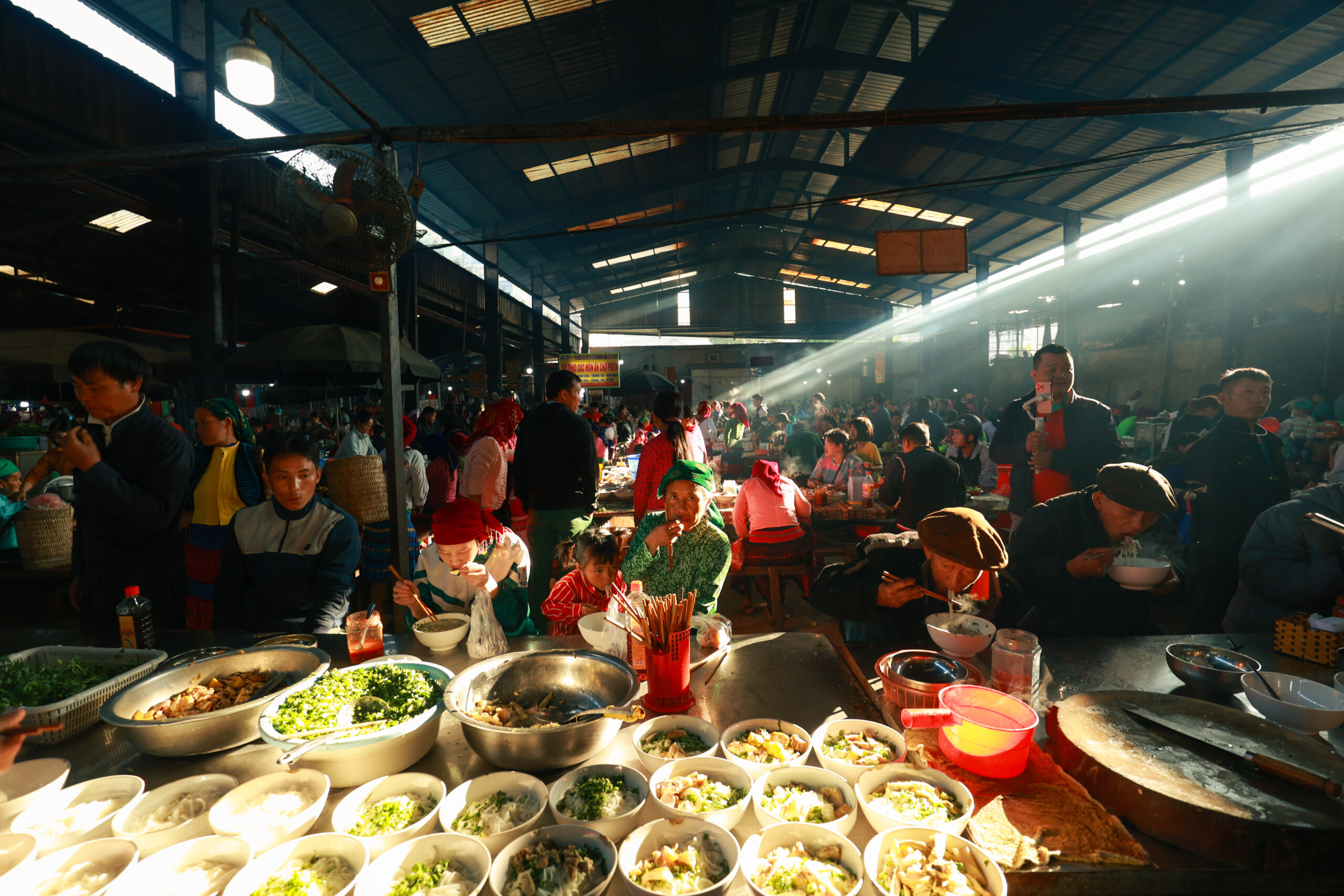
About 70 kilometers south, Du Gia offers a quieter, more rural escape. Nestled in a green valley of rice paddies, bamboo forests, the village is known for its cool waterfall and scenic trekking routes. Dirt paths wind through farms and low hills, making it ideal for gentle hikes. Early mornings start with the sound of roosters and farmers heading to the fields.
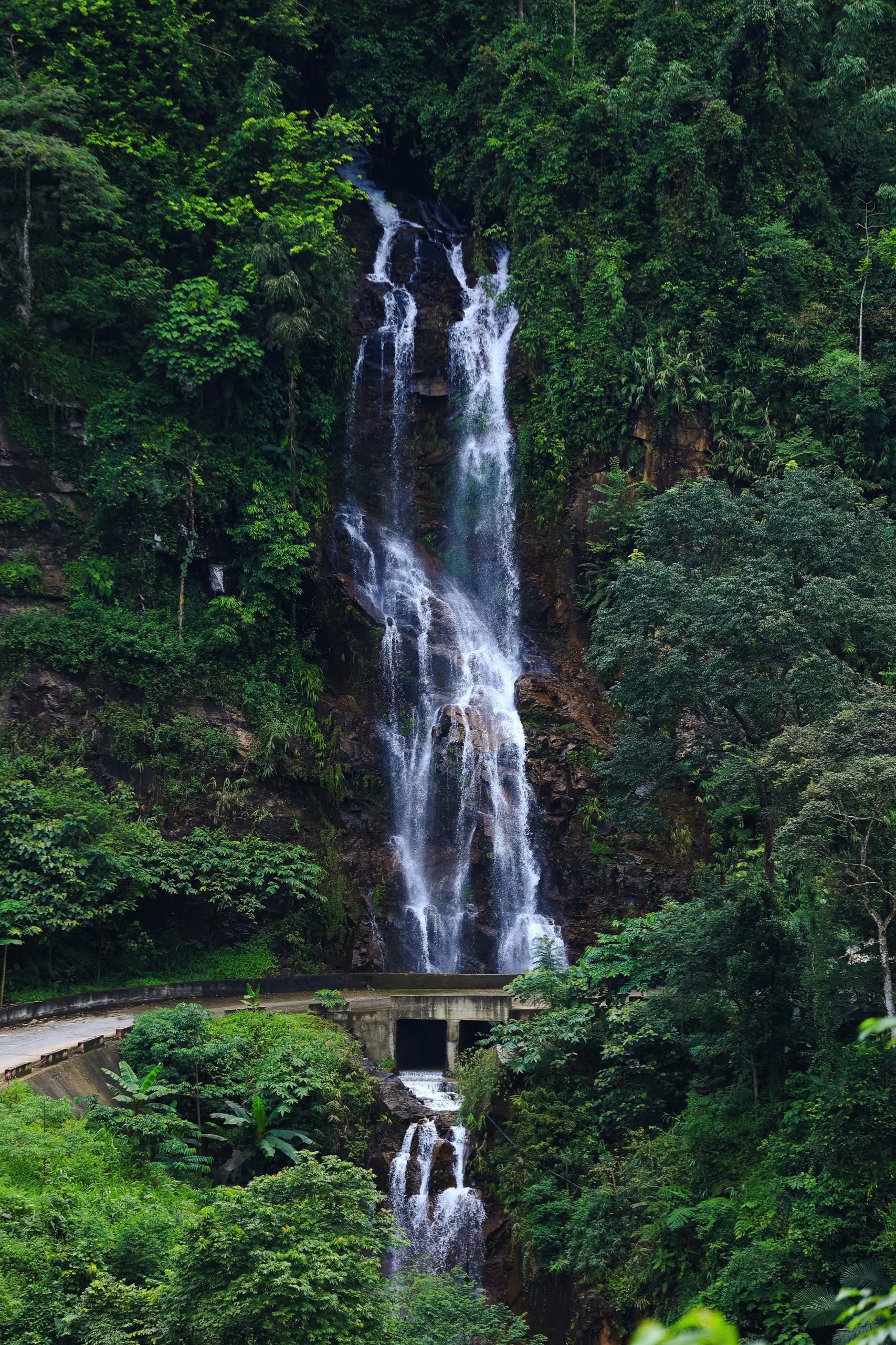
Both destinations remain largely untouched by mass tourism, preserving authentic ethnic culture and simple daily life. Homestays offer stilt-house accommodations, home-cooked meals and chances to join in farming or weaving with host families. Whether enjoying Meo Vac’s market energy or Du Gia’s valley quiet, travelers will find meaningful, culture-rich moments that highlight the best of northern Vietnam.
3. How to get to Ha Giang
Hanoi is the most common departure point for reaching Ha Giang, with a distance of around 300 kilometers. From here, you can choose between sleeper bus, private car or motorbike, depending on your budget and comfort with long-distance travel.
- Sleeper buses are the most convenient option. They usually depart in the evening and arrive early in the morning, taking around 6 to 7 hours. Ticket prices vary between 200,000 and 350,000 VND. Operators such as Hung Thanh, Hai Van, Bang Phan and Khai Huyen run daily routes from My Dinh or Giap Bat stations.
- Self-driving by car suits those familiar with mountain roads. The route includes steep, winding sections near Ha Giang. A mid-sized vehicle with good tires and basic repair tools is recommended. It is essential to check the weather forecast before departure.
- Motorbikes are an option for experienced riders. The ride takes 8 to 10 hours and passes through rural areas with varying road conditions. Wearing protective gear and starting early in the day are essential for safety, especially in foggy or rainy weather. The route offers multiple detour options for those seeking off-the-beaten-path experiences.
Once in Ha Giang, you can rent motorbikes to explore the Ha Giang motorbike loop. Daily rental prices range from 150,000 to 500,000 VND depending on bike type. If you’re not confident riding, easy rider tours with local drivers are available. These tours cover major attractions and include accommodation and meals.

To simplify your trip, Phieu Travel offers round-trip sleeper bus tickets from Hanoi and other northern cities. Upon arrival, you can choose between self-ride motorbike tours, easy rider options or shared car tours. All vehicles are safety-checked, with protective gear provided. Each group is accompanied by a local guide familiar with the Ha Giang Loop terrain, ensuring routes match weather and rider experience.
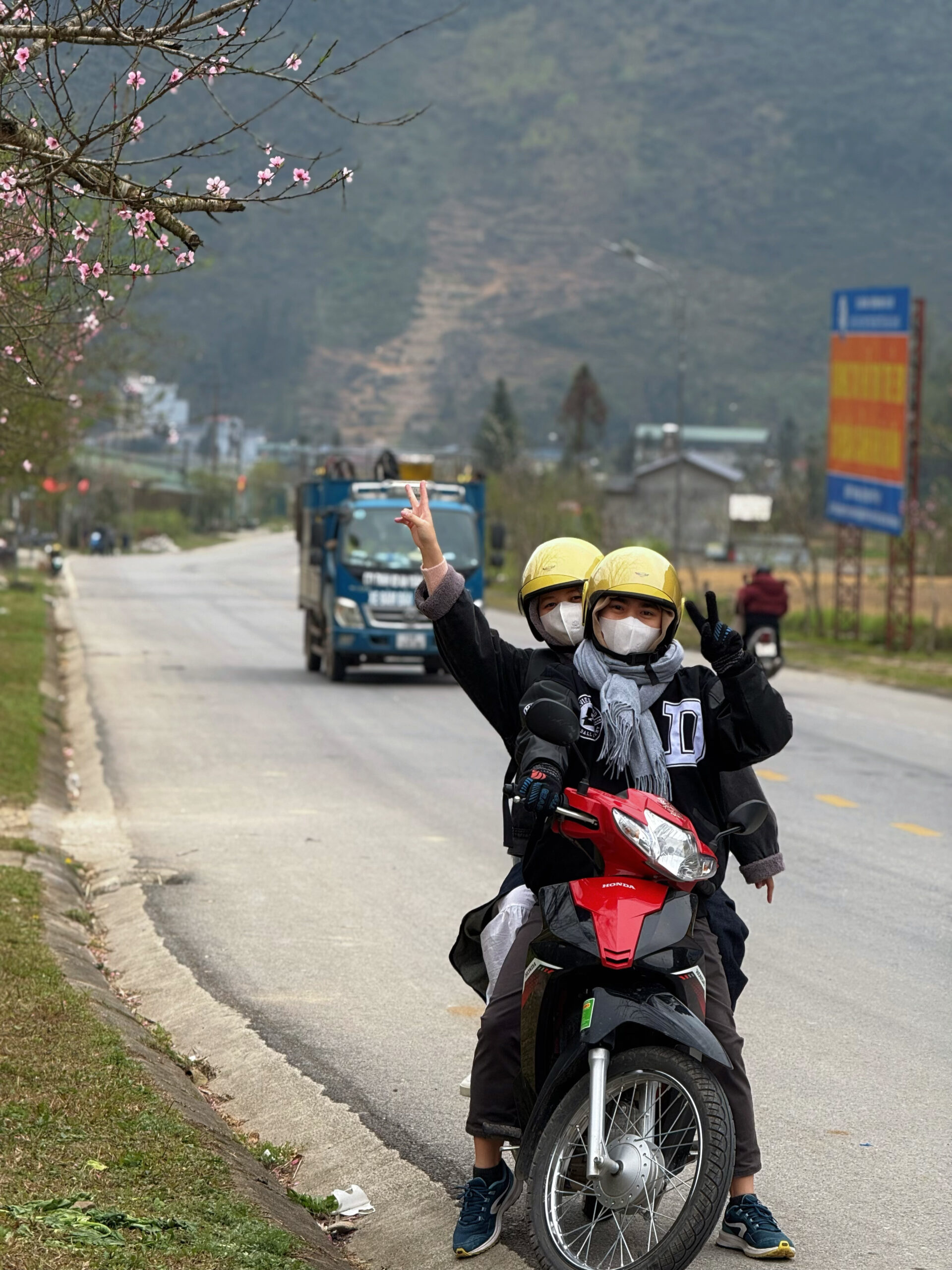
4. Best time to experience the Ha Giang Loop
The best time to explore the Ha Giang Loop is during the dry season, from October to April. During these months, the weather stays clear with little rainfall, making the mountain roads safer and the views more striking. Skies are often blue, and temperatures remain cool, especially in the early mornings and evenings.
For those drawn to seasonal landscapes, late September to October marks the rice harvest. Terraced fields turn golden, covering hillsides with warm, layered tones.
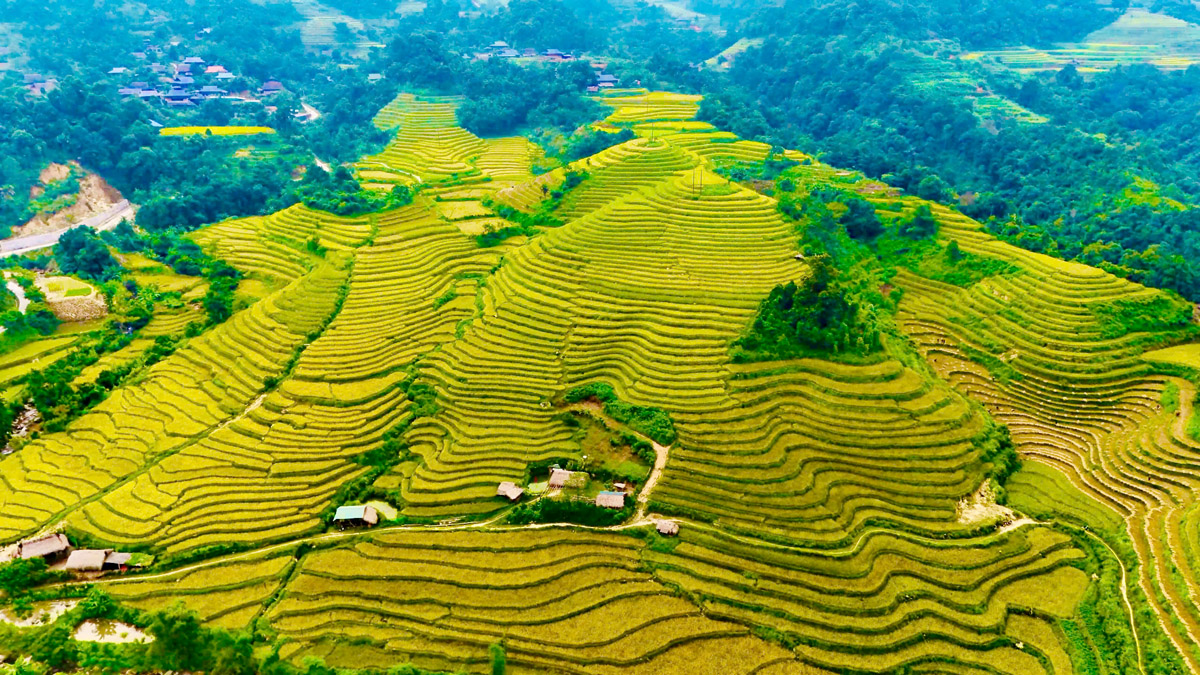
From October to November, buckwheat flowers bloom across the valleys, adding soft pink and purple shades to the limestone backdrop. These months also bring many local festivals and cultural gatherings, offering a rare chance to witness highland life at its most vibrant.
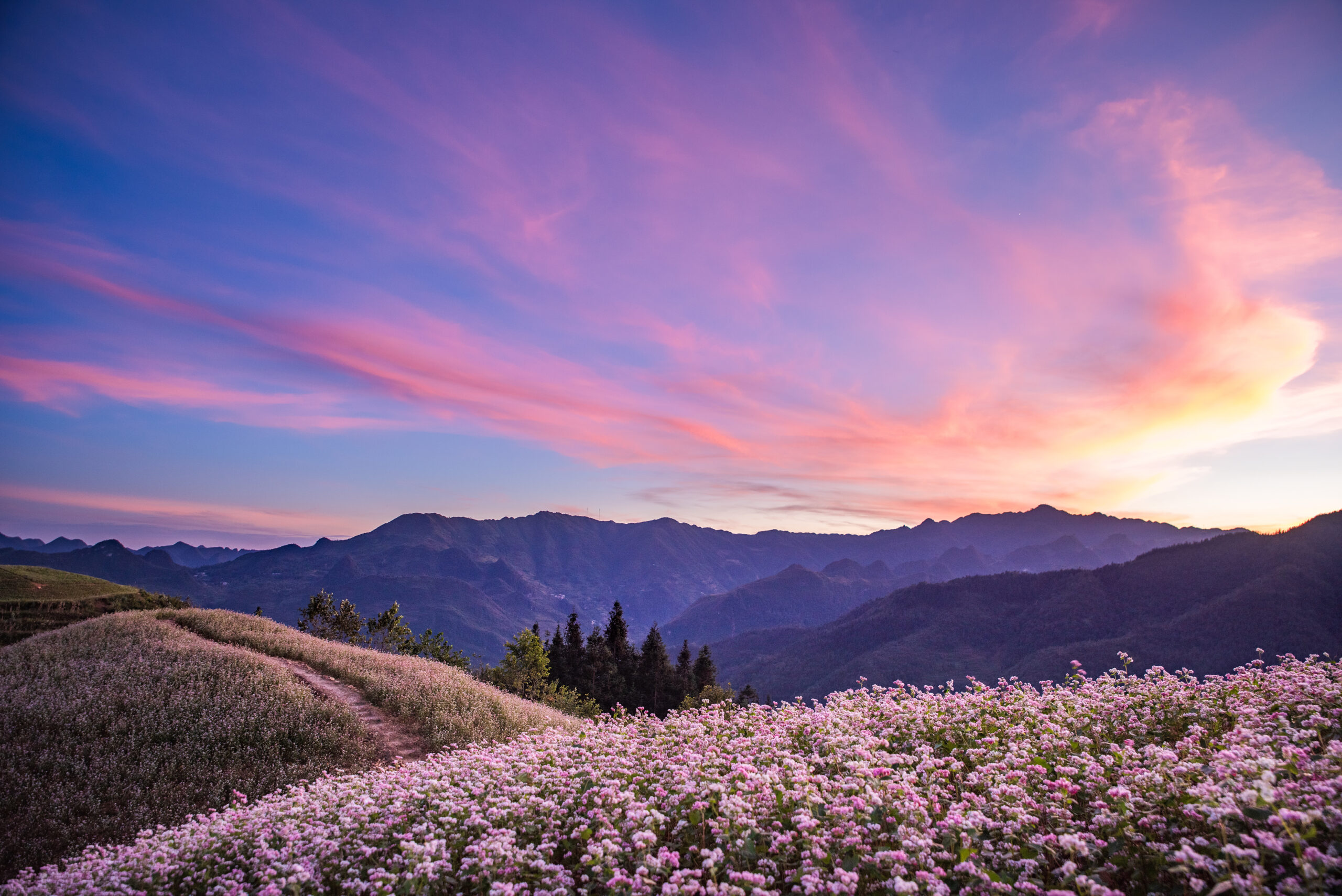
The Best Time to Visit Ha Giang: A Seasonal Guide to Flowers & Festivals
5. Suggested itinerary for the Ha Giang Loop
Depending on your time and travel style, the Ha Giang Loop can be explored over two, three, or four days. Each option offers a different pace and mix of landscapes, villages, and cultural stops. Below are three suggested Ha Giang Loop itinerary options: 2 days 1 night, 3 days 2 nights, and 4 days 3 nights. Each itinerary is designed to give you a clear idea of daily distances, main highlights, and travel flow along the route.
5.1 Ha Giang Loop 2 days 1 night itinerary
Although two days and one night is a relatively short time, a well-planned itinerary still allows you to experience much of the Ha Giang Loop’s beauty. Below is a suggested route for a 2-day, 1-night journey covering some of the most iconic landscapes and cultural highlights along the loop.
- Day 1: Ha Giang – Quan Ba – Yen Minh – Lo Lo Chai Village
The journey begins at Ha Giang’s Kilometer Zero milestone. From there, the route climbs through Bac Sum Pass, Heaven’s Gate in Quan Ba, and the famous Lonely Tree. Continue along steep slopes like Tham Ma Pass and Chin Khoanh Pass before reaching Lung Cam Cultural Village and the Hmong King’s Palace. The day ends with check-in at a homestay in Lo Lo Chai Village, offering a peaceful overnight stay.
- Day 2: Ma Pi Leng Pass – Nho Que River Boat Ride – Meo Vac
Start the day visiting Lo Lo Chai Village and the Lung Cu Flag Tower, marking Vietnam’s northernmost point. The journey continues over the scenic Ma Pi Leng Pass, with stops at Tu San Canyon, the famous M-shaped curve, and Can Ty slope. Enjoy a boat ride on the emerald waters of the Nho Que River. The final stop is Lung Tam Linen Weaving Village before returning to Ha Giang City and the sleeper bus back to Hanoi.
2 Days 1 Night Ha Giang Loop: Full itinerary with must-see stops and local insights
5.2 Ha Giang Loop 3 days 2 nights itinerary
For travelers with a bit more time, a 3-day, 2-night itinerary offers a better balance between scenic drives and cultural stops. This schedule allows you to explore key highlights of the Ha Giang Loop at a more relaxed pace, with two overnight stays along the way.
- Day 1: Ha Giang – Quan Ba – Yen Minh – Lo Lo Chai Village
From Kilometer Zero in Ha Giang City the road climbs gently through Bac Sum Pass, revealing wide valley views at Heaven’s Gate in Quan Ba. The Lonely Tree stands quietly by the roadside, marking the changing landscape. After Tham Ma and Chin Khoanh passes, the route leads to Lung Cam Cultural Village and the Hmong King’s Palace. The day ends with check-in at a stilt house homestay in Lo Lo Chai Village.
- Day 2: Lo Lo Chai – Lung Cu Flag Tower – Ma Pi Leng Pass – Nho Que River – Meo Vac
Morning in Lo Lo Chai brings soft light over stone houses and terraced fields. After breakfast, the journey continues to Lung Cu Flag Tower, offering views toward distant valleys. The road then follows Ma Pi Leng Pass, where limestone cliffs drop sharply to the Nho Que River below. Midday includes a boat ride through Tu San Canyon. The day finishes with an overnight stay in Meo Vac town.
- Day 3: Meo Vac – M-shaped Curve – Ha Giang – Hanoi
If it’s Sunday, Meo Vac Market comes alive with colors and voices from nearby villages. The road then winds past the M-shaped slope and terraced hills of Can Ty. Before reaching Ha Giang City, stop at Lung Tam Village to see Hmong weaving in progress. After dinner and a short rest, the sleeper bus takes you back to Hanoi, ending the journey through the northern highlands.
3 Days 2 nights Ha Giang Loop tour package from Phieu Travel
5.3 Ha Giang Loop 4 days 3 nights itinerary
Four days and three nights offer enough time to truly experience Ha Giang Loop. This itinerary balances scenic views, local culture, and peaceful villages for a complete journey through northern Vietnam’s highlands.
- Day 1: Ha Giang – Quan Ba – Yen Minh – Lo Lo Chai Village
Starting from Ha Giang’s Kilometer Zero, the road winds through Bac Sum Pass and Heaven’s Gate, revealing sweeping valley views. The Lonely Tree marks a quiet pause before the journey continues over Tham Ma and Chin Khoanh passes. Visiting Lung Cam Cultural Village and the Hmong King’s Palace introduces you to local heritage. The day closes with a warm welcome at a stilt-house homestay in Lo Lo Chai Village.
- Day 2: Ma Pi Leng Pass – Nho Que River Boat Ride – Meo Vac
Morning light illuminates Lo Lo Chai’s stone houses and terraced fields. A drive to Lung Cu Flag Tower offers panoramic views near the Chinese border. Ma Pi Leng Pass presents towering cliffs and sharp bends, while a boat trip on the emerald Nho Que River through Tu San Canyon immerses you in dramatic natural beauty. The day ends in Meo Vac – a bustling town nestled among limestone peaks.
- Day 3: Meo Vac – M-shaped Curve – Historical Sites – Du Gia Village
If it’s Sunday, Meo Vac Market bursts with color and local life as ethnic groups gather. The road then hugs mountain edges past the iconic M-shaped curve and Can Ty slopes. A visit to French colonial relics adds historical depth before reaching serene Du Gia Village. Here, lush forests and quiet rice paddies invite peaceful reflection after days of travel.
- Day 4: Du Gia – Ha Giang – Hanoi
Early morning in Du Gia reveals mist-shrouded valleys and tranquil farms. The return trip to Ha Giang City offers a chance to rest and enjoy local flavors. After a final meal, board the sleeper bus for the journey back to Hanoi, carrying memories of Ha Giang’s rugged beauty and rich cultural tapestry.
4 Days 3 nights Ha Giang Loop tour: Slow down, see more, feel more
6. What to eat on the Ha Giang Loop route
Exploring northern Vietnam’s highlands reveals breathtaking landscapes and a rich culinary heritage. The region’s highland cuisine reflects its culture and environment, offering dishes steeped in history and tradition with unique, bold flavors. Below are some must-try specialties that truly capture the essence of this mountainous area.
Thang co is a signature H’mong stew, simmered slowly from horse or buffalo meat and offal, enriched with star anise, cinnamon, and lemongrass. Its rich aroma and hearty taste invite travelers to savor a genuine cultural experience.
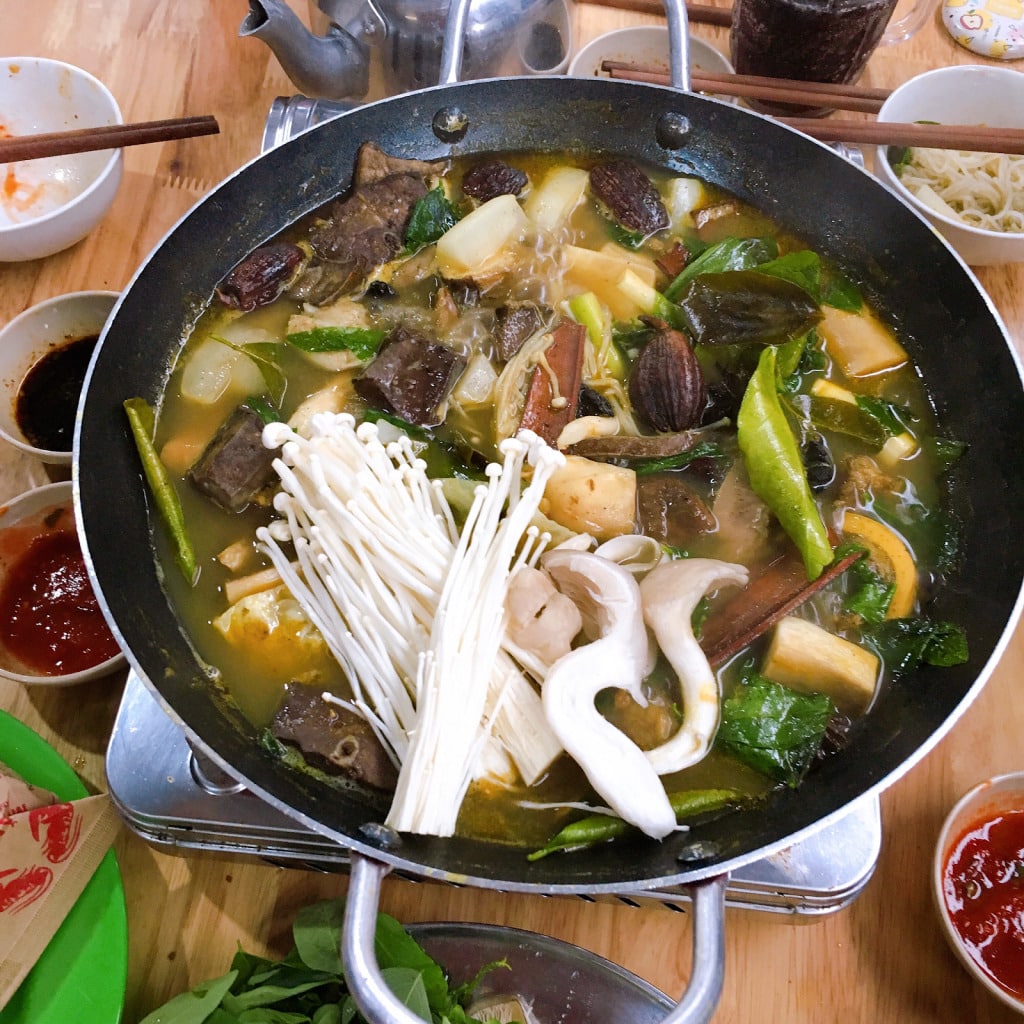
The famed black chicken boasts firm, fragrant meat, often cooked with local herbs that highlight the natural flavors. It’s a dish that reflects the harmony between the people and their mountainous environment.
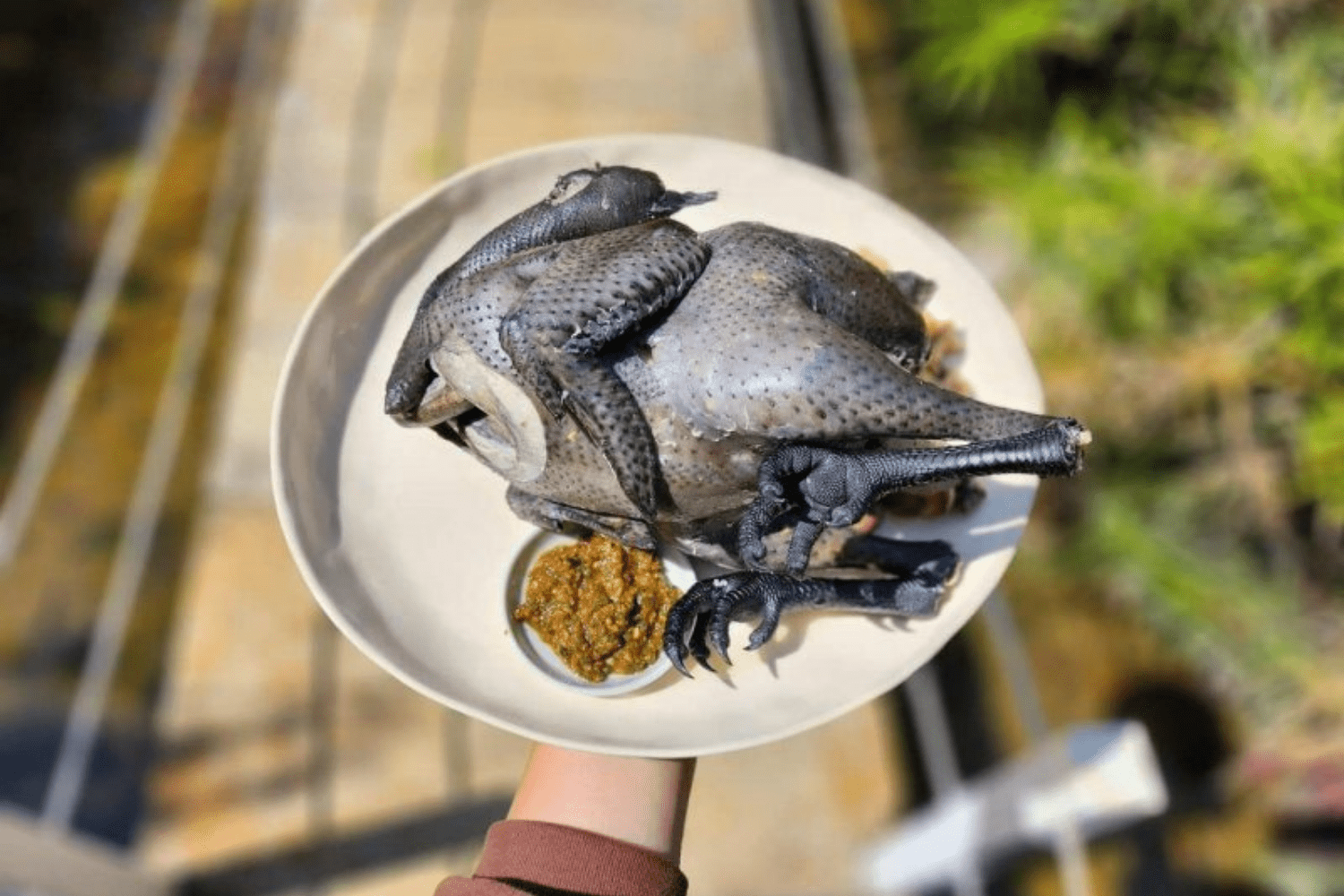
Raised freely on mountain slopes, the free-range pork offers tender, aromatic meat with a distinct taste shaped by natural foraging. Typically grilled or braised, this delicacy captures the essence of Ha Giang’s rural life.
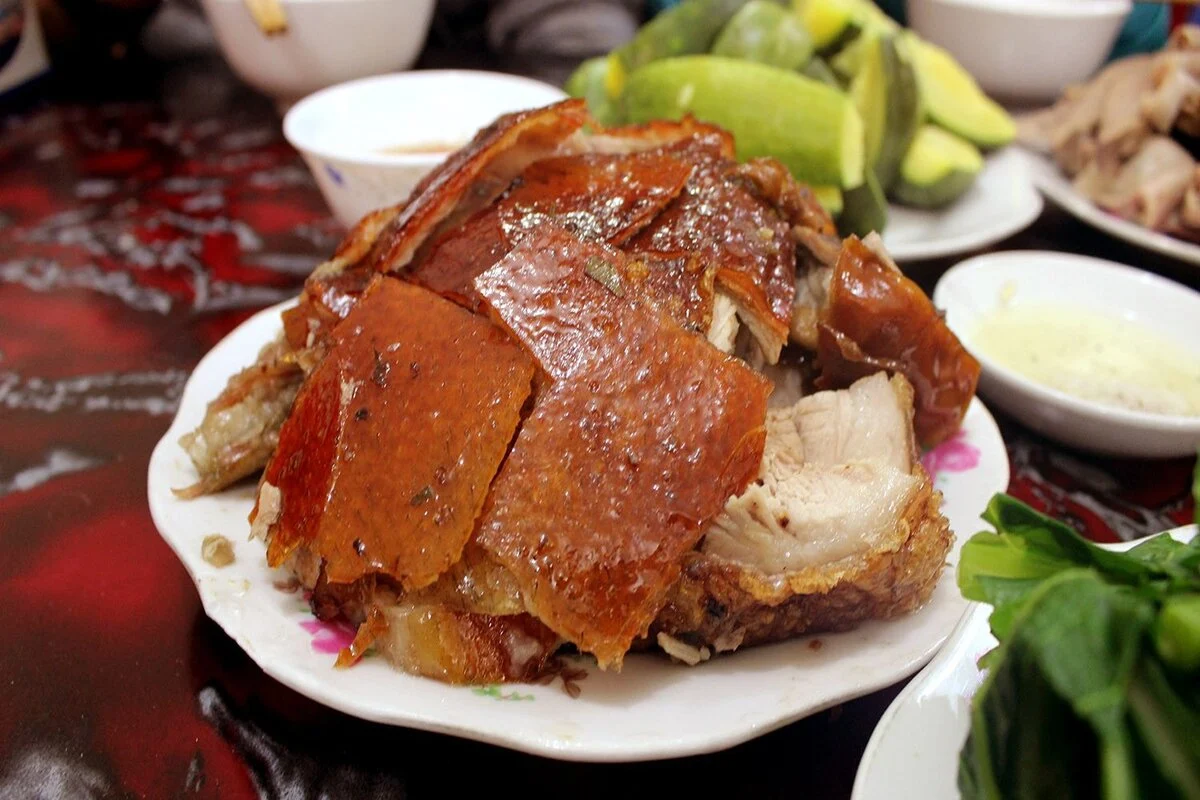
Five-color sticky rice brightens festive occasions with its symbolic hues representing the five elements. This delicately prepared dish is a testament to the Tay ethnic group’s culinary artistry.
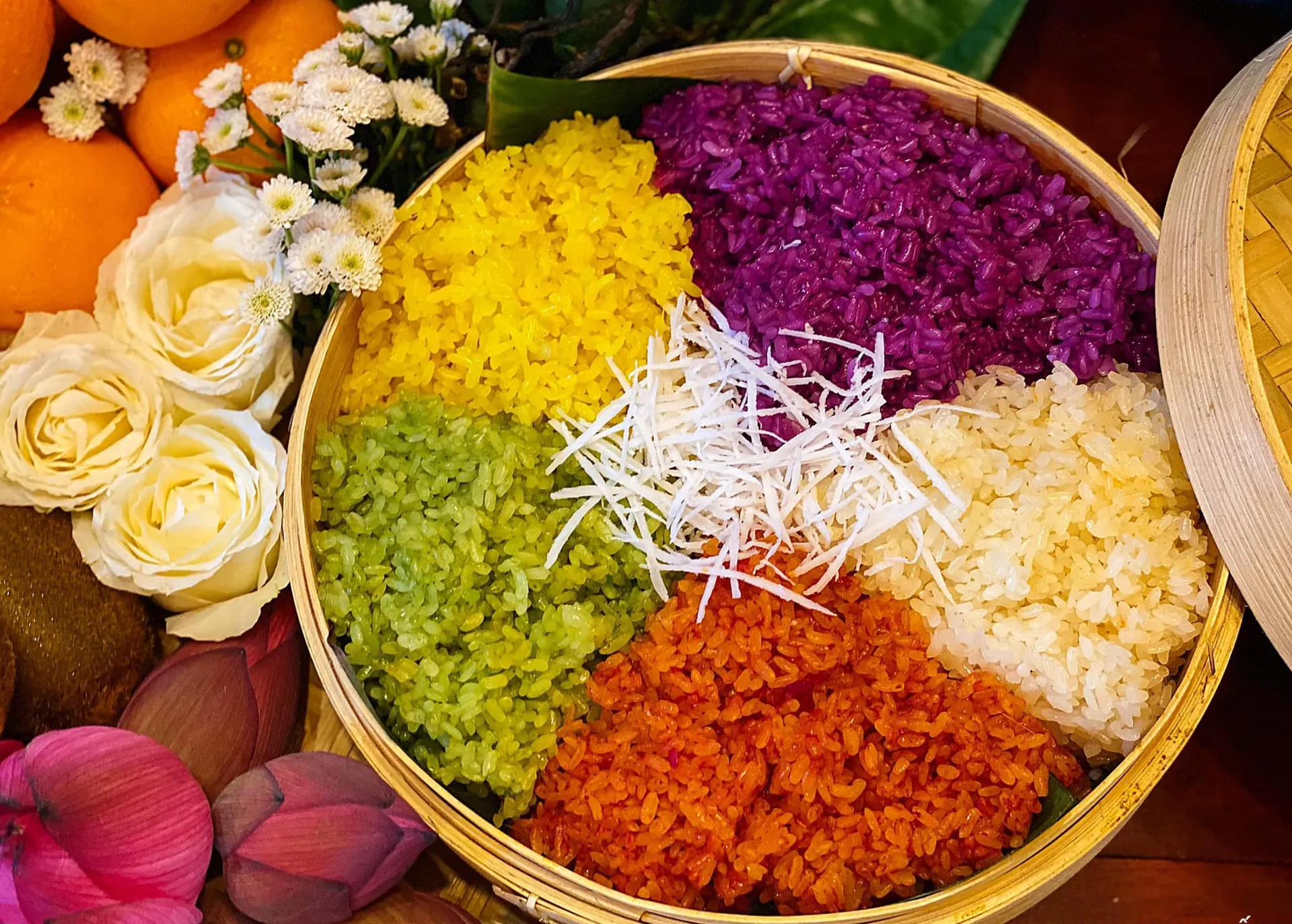
Smoked meats such as buffalo or pork bring deep, savory notes to traditional meals. Paired with corn wine, a potent spirit fermented from local corn, they embody the warmth and hospitality of Ha Giang’s celebrations.

7. Where to stay in Ha Giang
Local homestays remain a popular choice for travelers seeking genuine cultural immersion. Located within ethnic villages, these homestays offer affordable rooms with breathtaking views of terraced fields and mountains. More importantly, they provide rare chances to connect with host families and experience daily highland life firsthand.
For those who prefer more convenience, small hotels and guesthouses in towns like Dong Van, Yen Minh, and Ha Giang city deliver comfortable amenities while maintaining local charm.
Budget travelers and backpackers often choose eco-lodges and hostels dotted along the loop. These spots encourage socializing among fellow explorers and offer a closer connection to nature.
8. Key advice for traveling the Ha Giang Loop
Traveling the Ha Giang Loop requires careful preparation and respect for local culture and nature. Keeping these tips in mind will help you enjoy a safe, smooth journey:
- Prepare your health and develop mountain riding skills, as the roads can be demanding.
- Carry important documents, sufficient cash, and basic medicines due to limited services in remote areas.
Use a detailed Ha Giang Loop map to navigate the terrain confidently and plan your stops well. - Book accommodations and vehicle rentals in advance, especially during peak seasons.
- Respect local customs and traditions; engage respectfully with ethnic communities.
- Protect the environment by minimizing waste and preserving natural landscapes along the route.
Ha Giang Loop offers stunning landscapes and rich culture. Proper preparation ensures a safe, smooth trip. Respecting local customs and nature enriches the experience. With the trusted companionship of Phieutravel.com, your journey through Vietnam’s northern highlands becomes truly memorable.
You Might Also Like:
- Brocade Clothes in Ha Giang: 6 Ethnic Styles You Should Know
- Exploring Highland Cuisine: 20 Must-Try Dishes in Ha Giang
- Ha Giang Motorbike Loop: The Ultimate Tour with Phieu Travel
- Ha Giang Jeep Tour by Phieu Travel: The Ultimate Adventure on the Ha Giang Loop (2025)




